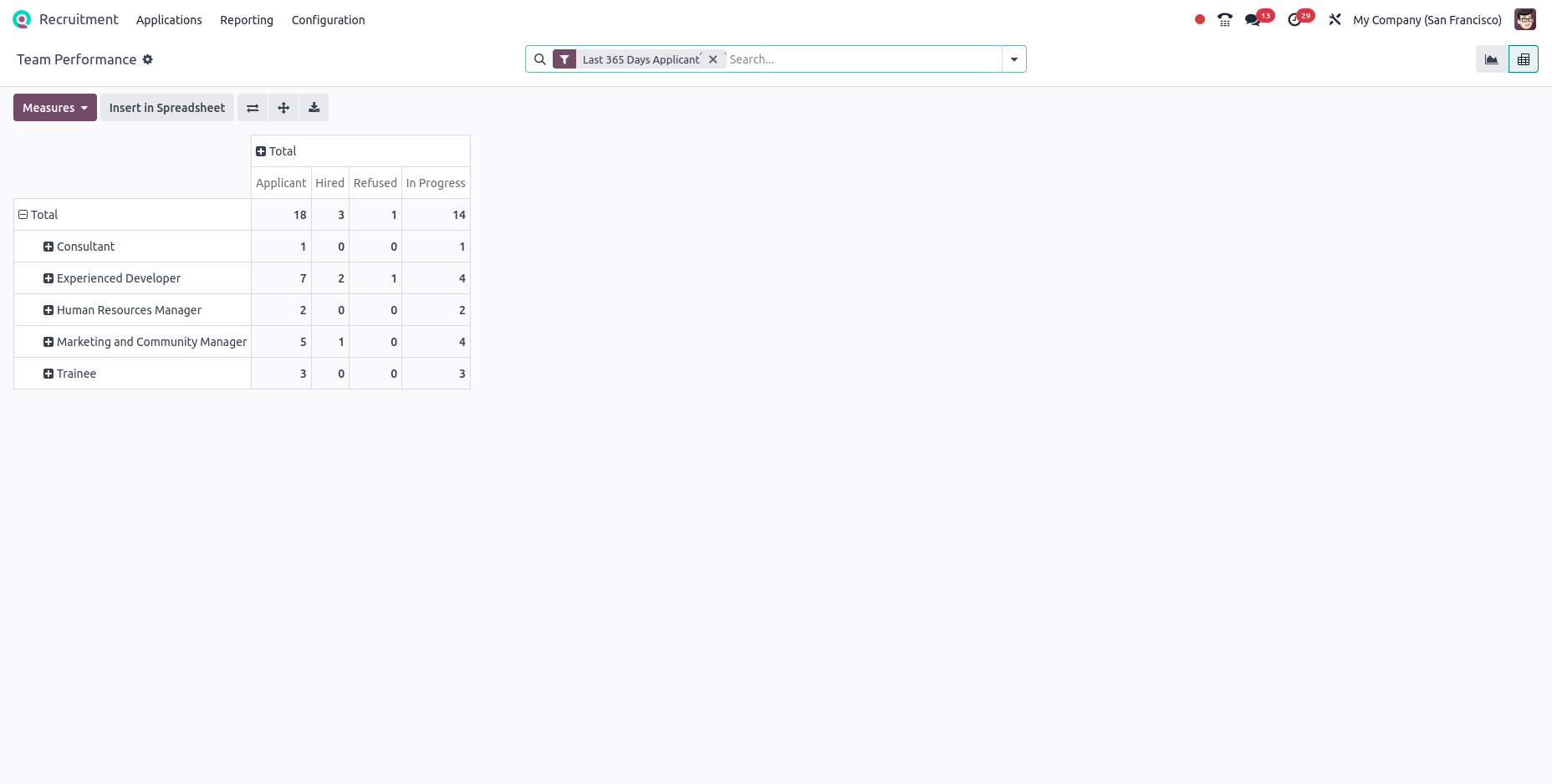Odoo Recruitment
Odoo Recruitment Management organizes all job applicants through a preconfigured sequence of stages, known as the applicant flow. Each stage defines specific actions, such as scheduling a phone call, conducting an interview, or sending a job offer, ensuring a consistent and structured recruitment process.
The following are the list of Main Recruitment features available in Odoo,
- Create and publish job openings quickly.
- Post jobs directly to your company website and popular job boards (LinkedIn, Indeed, etc.) via integrations.
- Sent interview survey to the applicant
- Display resume on application form
- Set Clear Validity Periods for Salary Package Offers to Streamline Recruitment
- Recruitment Communication with Direct SMS Messaging to Applicants
- Digitize resume to extract name and email automatically
- Customize Hiring Stages to Perfectly Align with Your Recruitment Process
- Manage and Monitor Job Positions Easily with an Intuitive Dashboard
- Manage multiple job positions and departments
- Centralized dashboard to track all candidates and their application statuses
- Move candidates through different pipeline stages: New, Interview, Offer, Hired, Rejected
- Easily Add and Manage Applicants
- Schedule interviews and send calendar invites
- Generate offer letters directly in Odoo.
- Quickly Convert Hired Applicants into Employees
- Easily Manage Applicant Refusal Process
- Advanced Recruitment Analytics: Source Tracking, Applicant Flow, Stage Timing, and Team Performance
Key Benefits
- All job positions, applications and candidate data are stored in one place
- Define and modify your recruitment stages per job position
- Publish job vacancies directly on your company website and job boards
Recruitment Management Workflow
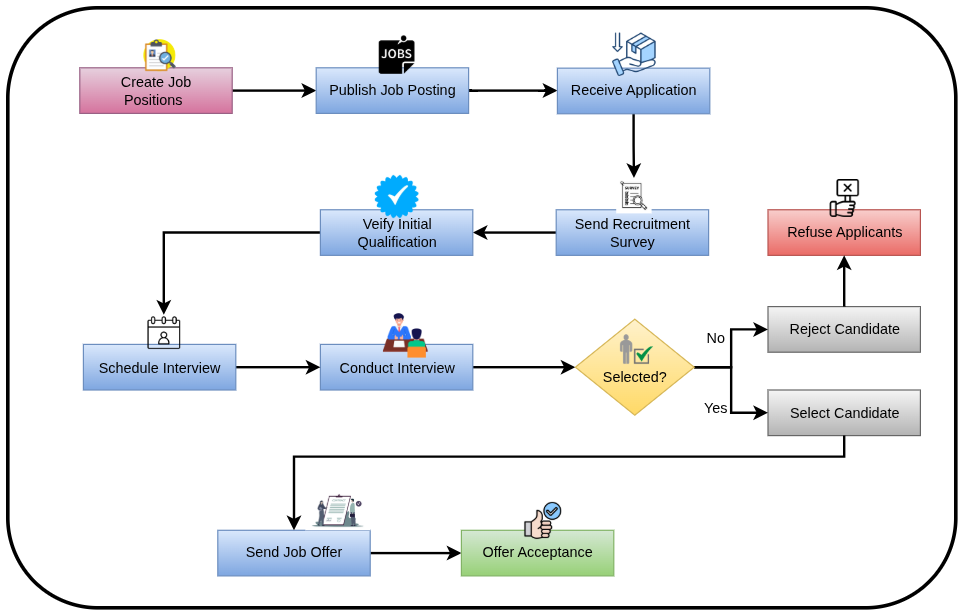
Recruitment Master Management
Following are the list of masters which support for Recruitment process,
- Recruitment Candidates
- Candidate Degrees
- Refuse Reasons
- Offer Refusal Reasons
- Job-board Emails
- Interview Survey Form
- Job Position Stages
- Employment Types
- Sources
- Mediums
- Departments
- Skill Types
- Activity Types
- Recruitment Plans
- Tags
Recruitment Candidates
Overview
Candidates are created automatically via job applications or manually by recruiters, with key details and documents added. They’re instantly added to the recruitment pipeline for streamlined tracking and evaluation.
Process Flow
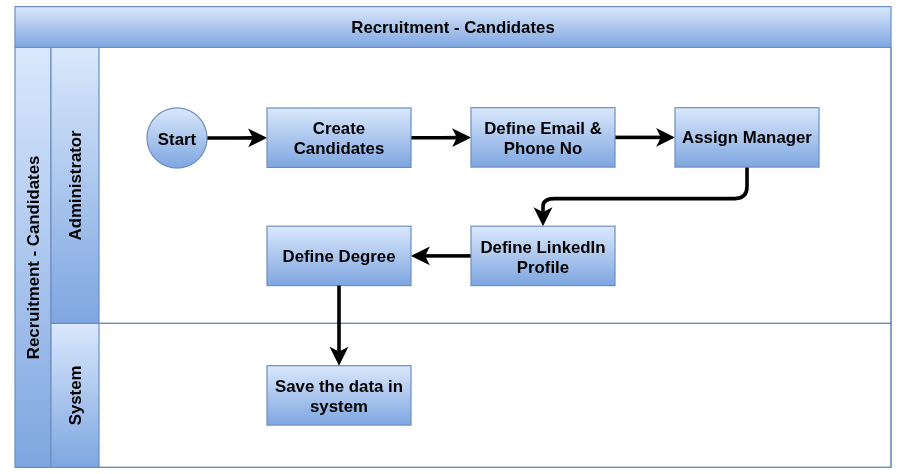
Business Rules
- The Candidate Name field must be mandatory
- Manager selected based on selected company
Screenshots


Candidate Degrees
Overview
Degrees are used to track a candidate’s educational background by adding degree details. This information can be added manually during candidate profile creation or updated later, helping HR teams assess qualifications directly within the recruitment pipeline.
Process Flow

Business Rules
- The Degree Name field must be mandatory
Screenshots

Refuse Reasons
Overview
Refuse Reasons allow recruiters to record specific reasons when rejecting candidates, providing clear feedback and helping to improve the hiring process. These reasons are tracked in the system for reporting and transparency.
Process Flow

Business Rules
- The Refuse Reasons Description field must be mandatory
Screenshots
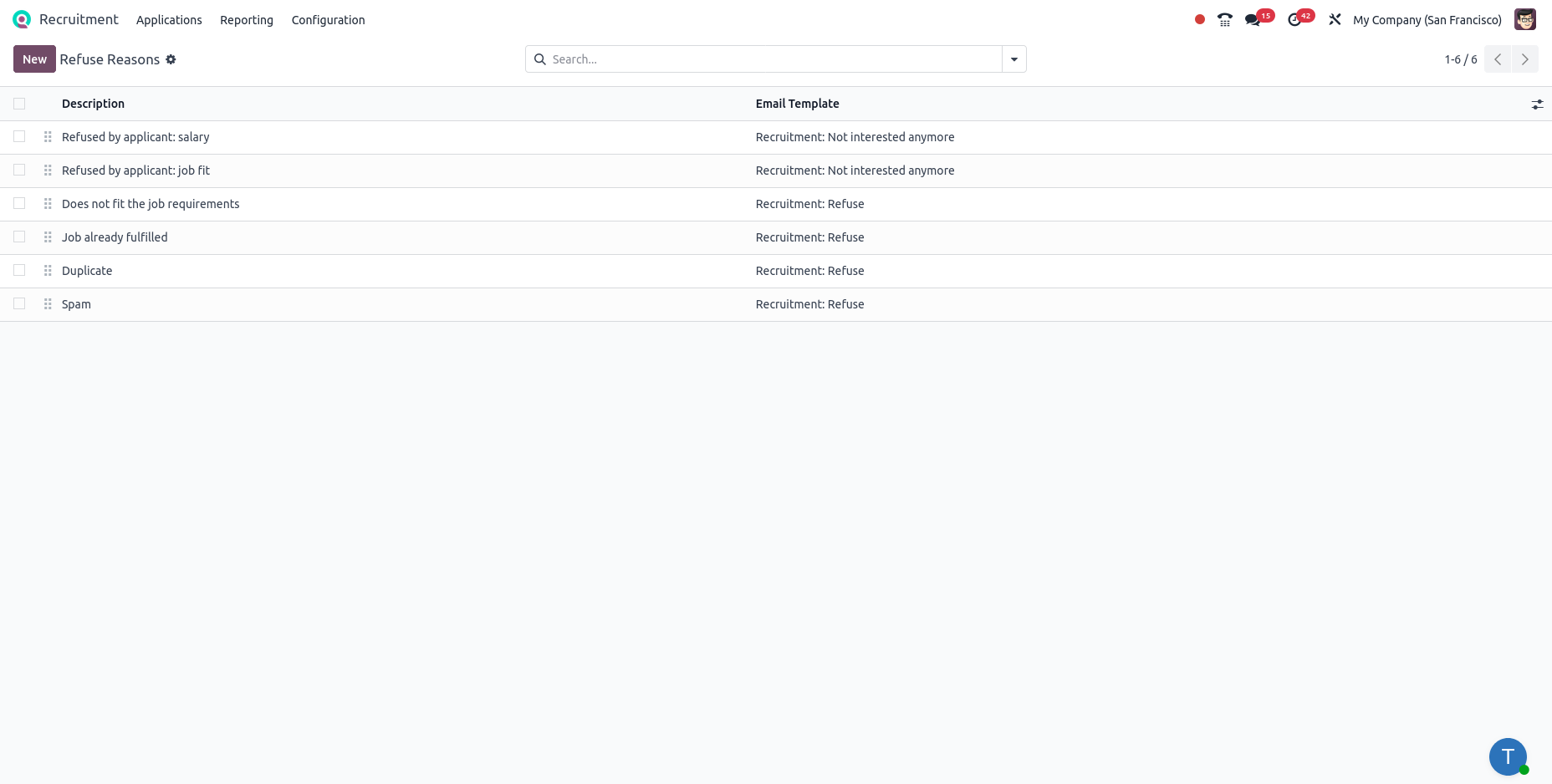
Offer Refuse Reasons
Overview
Offer Refuse Reasons allow recruiters to log specific reasons when a candidate declines a job offer. This helps HR teams analyze offer rejections, identify trends, and refine their recruitment or compensation strategies.
Process Flow
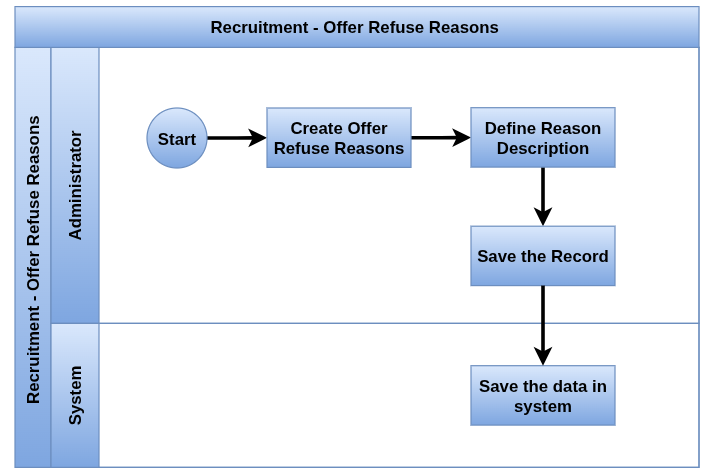
Business Rules
- The Offer Refuse Reasons Description field must be mandatory
Screenshots
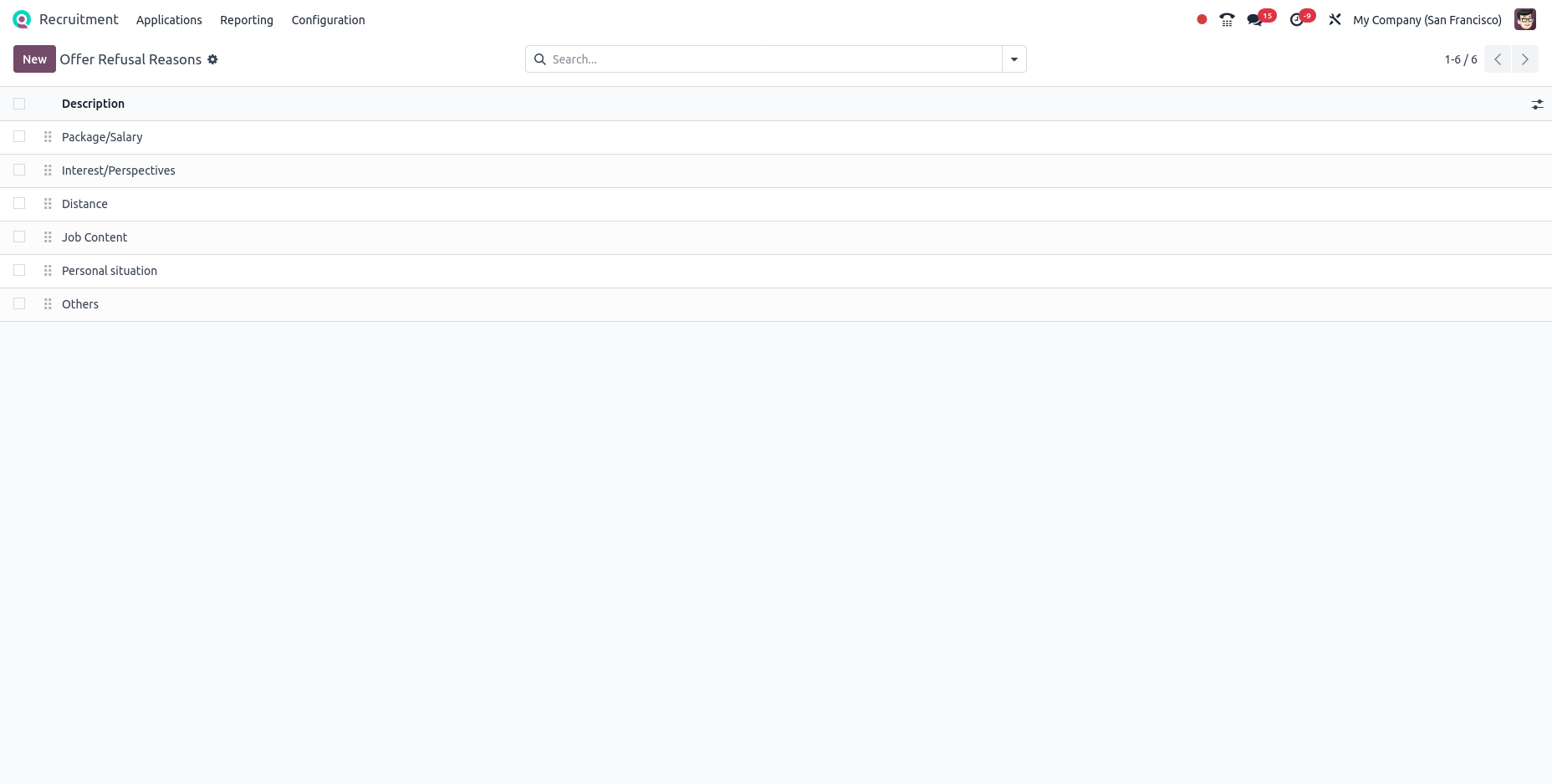
Job-board Emails
Overview
Job-Boards Emails enable automatic collection of candidate applications sent via email from various job boards. Odoo parses these emails, creates candidate records, and links them to the relevant job positions, streamlining application management and reducing manual data entry.
Process Flow
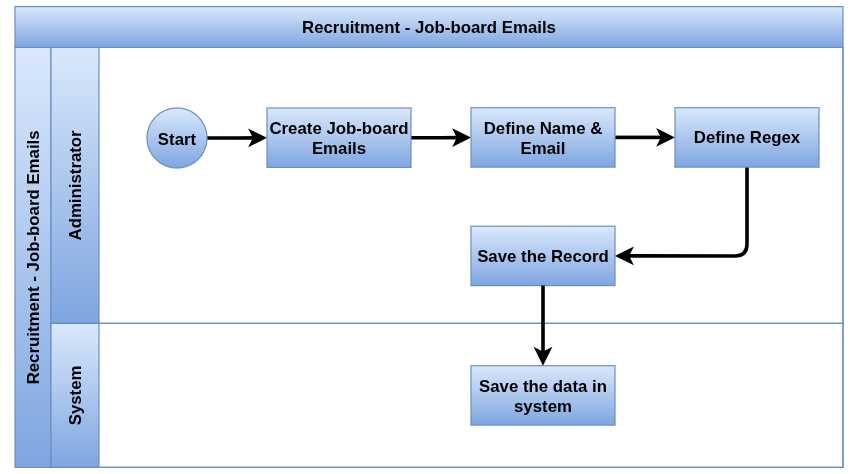
Business Rules
- The Name and Email field must be mandatory
Screenshots
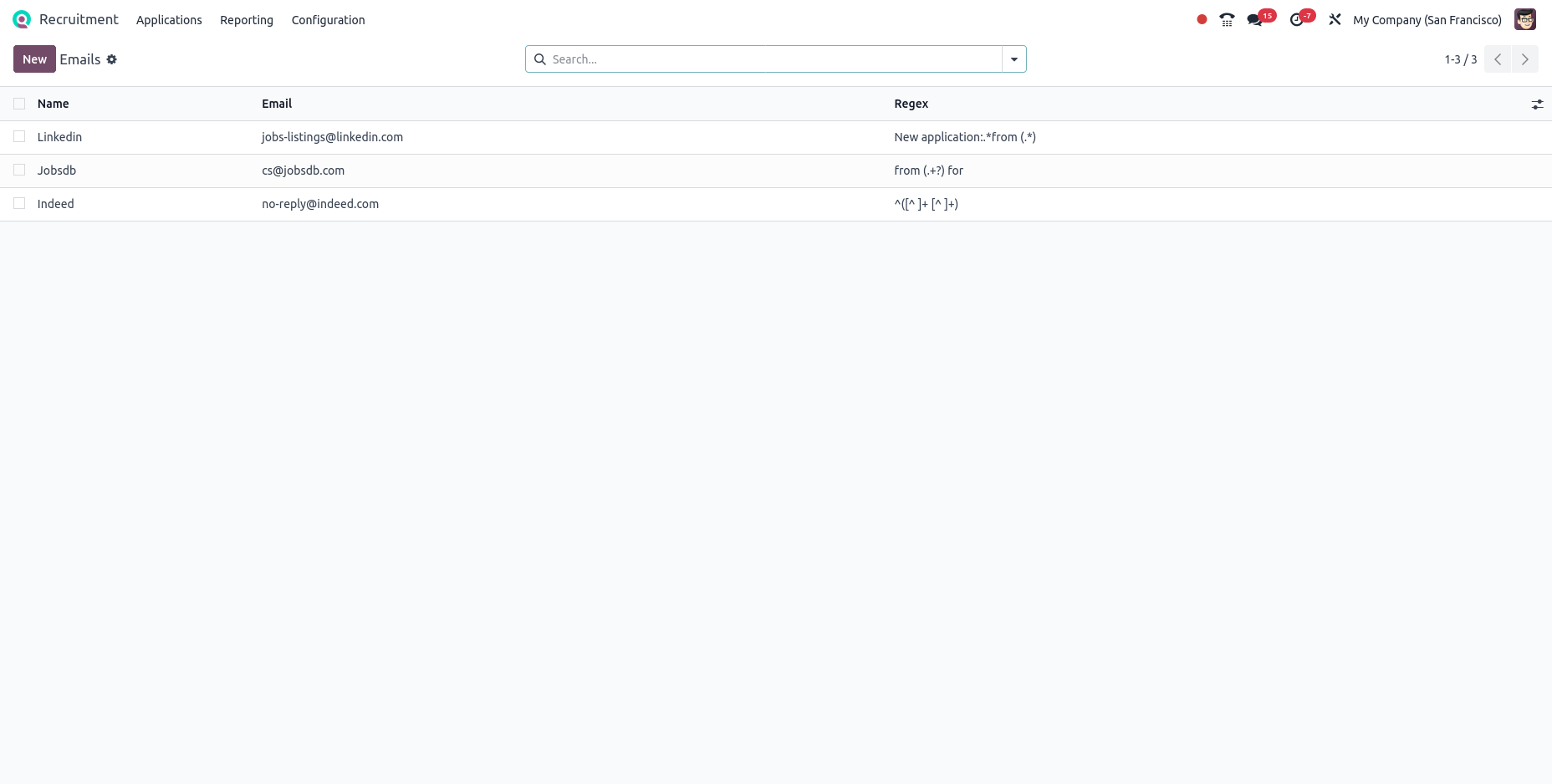
Interview Survey Form
Overview
The Interview Survey Form allows interviewers to provide structured feedback on candidates through customizable questionnaires. This helps standardize evaluations, capture detailed insights, and supports better hiring decisions.
Process Flow
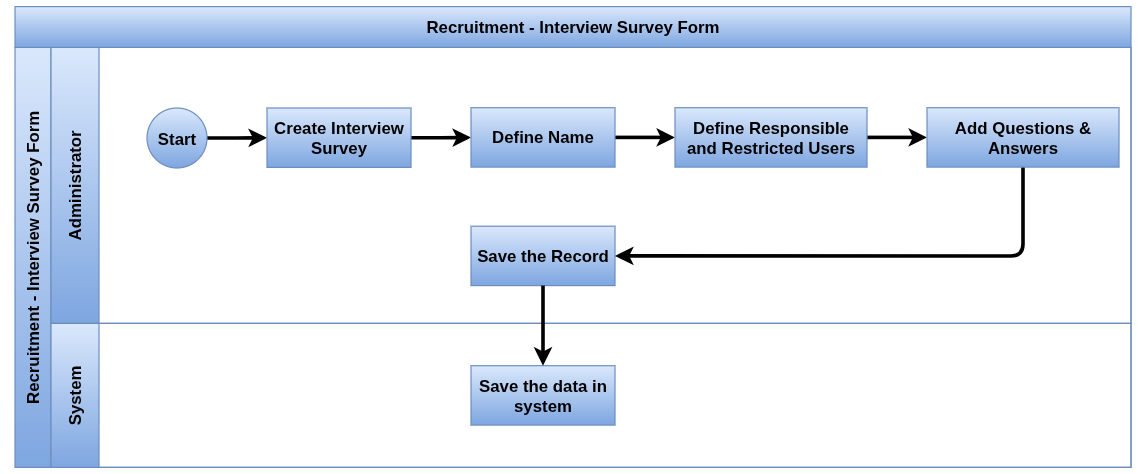
Business Rules
- The Name field must be mandatory
- An interview form name must be selected or provided before adding any questions
- The Question Title field must be mandatory
Screenshots
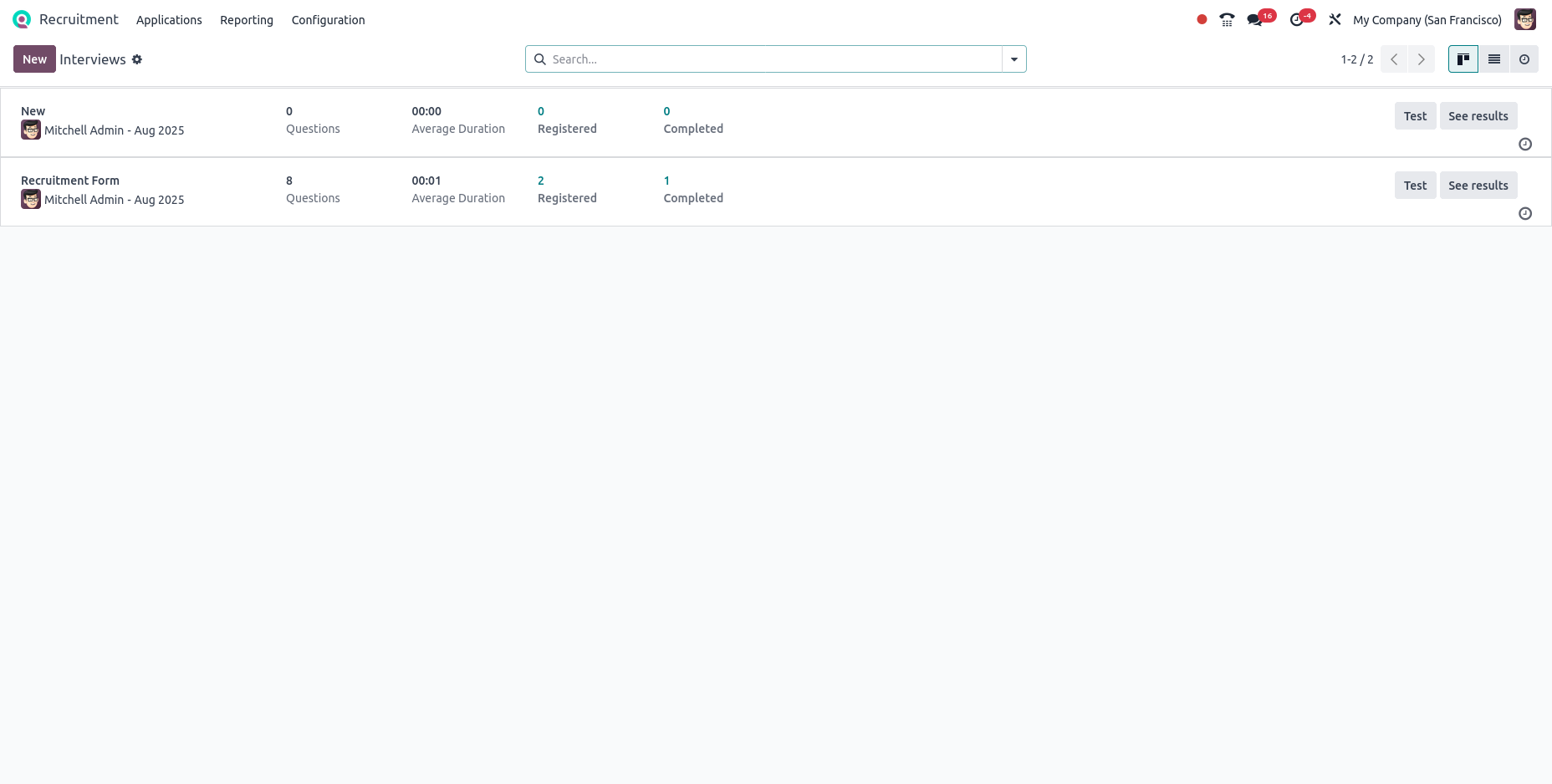
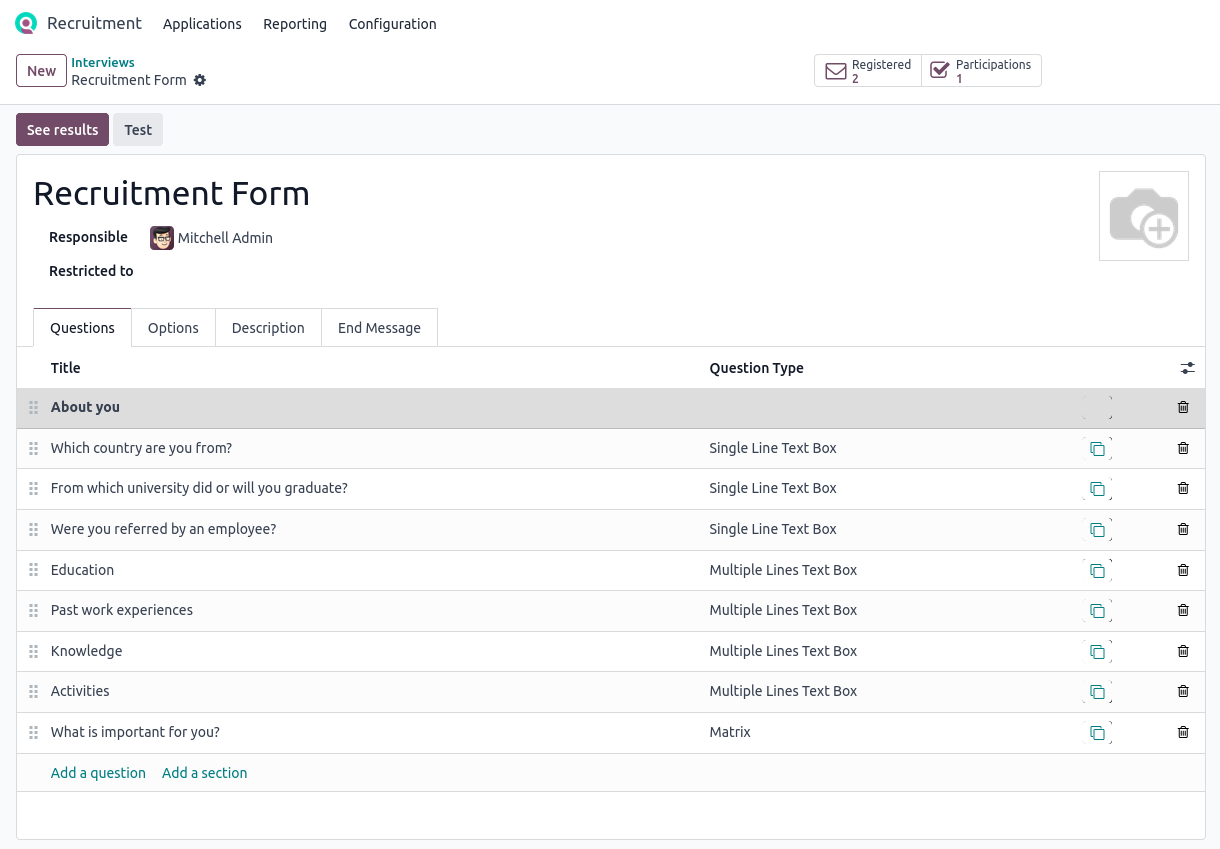
Application Stages
Overview
Application stages represent the steps or phases in your recruitment process. Each stage reflects the status of a job application, from the initial receipt of a resume to the final hiring decision.
Process Flow
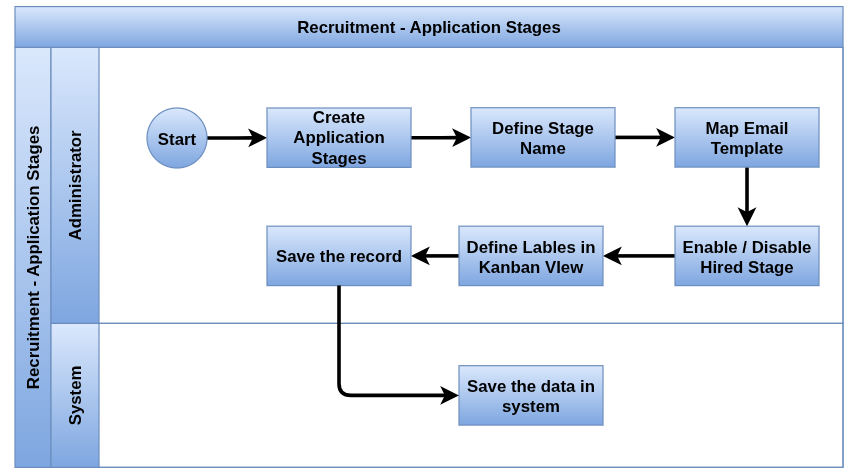
Business Rules
- The Stage Name field must be mandatory
Screenshots
Stages Tree View
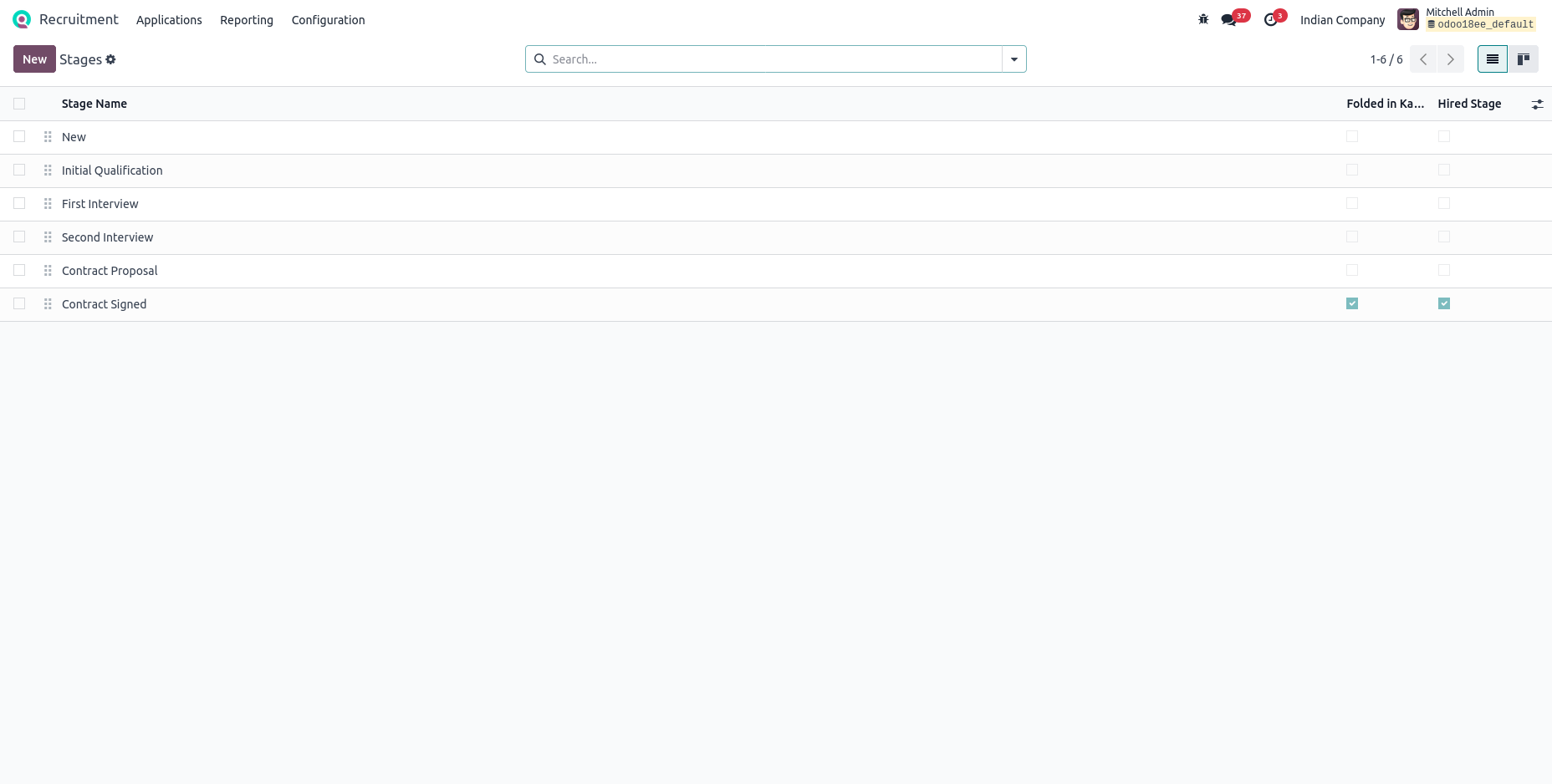
Stages Form View

Employment Types
Overview
Employment Types refer to the classification of employee contracts based on their working relationship with the company. These help define key parameters for HR, payroll, and contract management. They are typically used when creating or managing employee contracts and are essential for accurate reporting, compliance, and automation of HR processes.
Process Flow
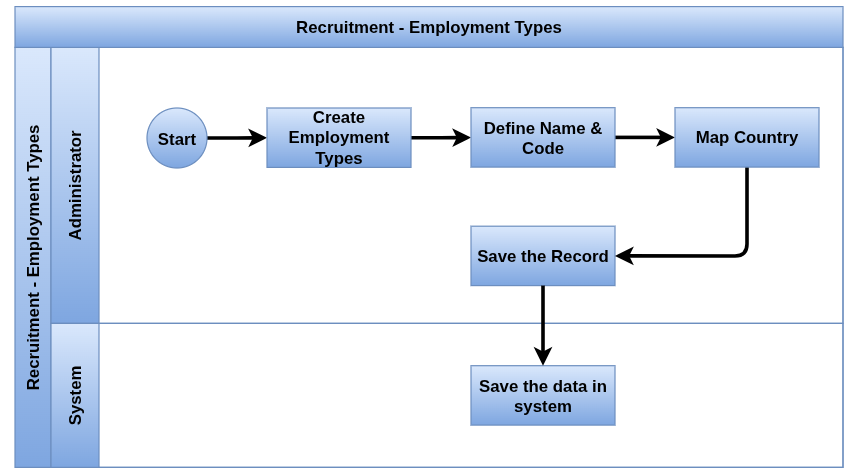
Business Rules
- The Employment Types Name field must be mandatory
Screenshots
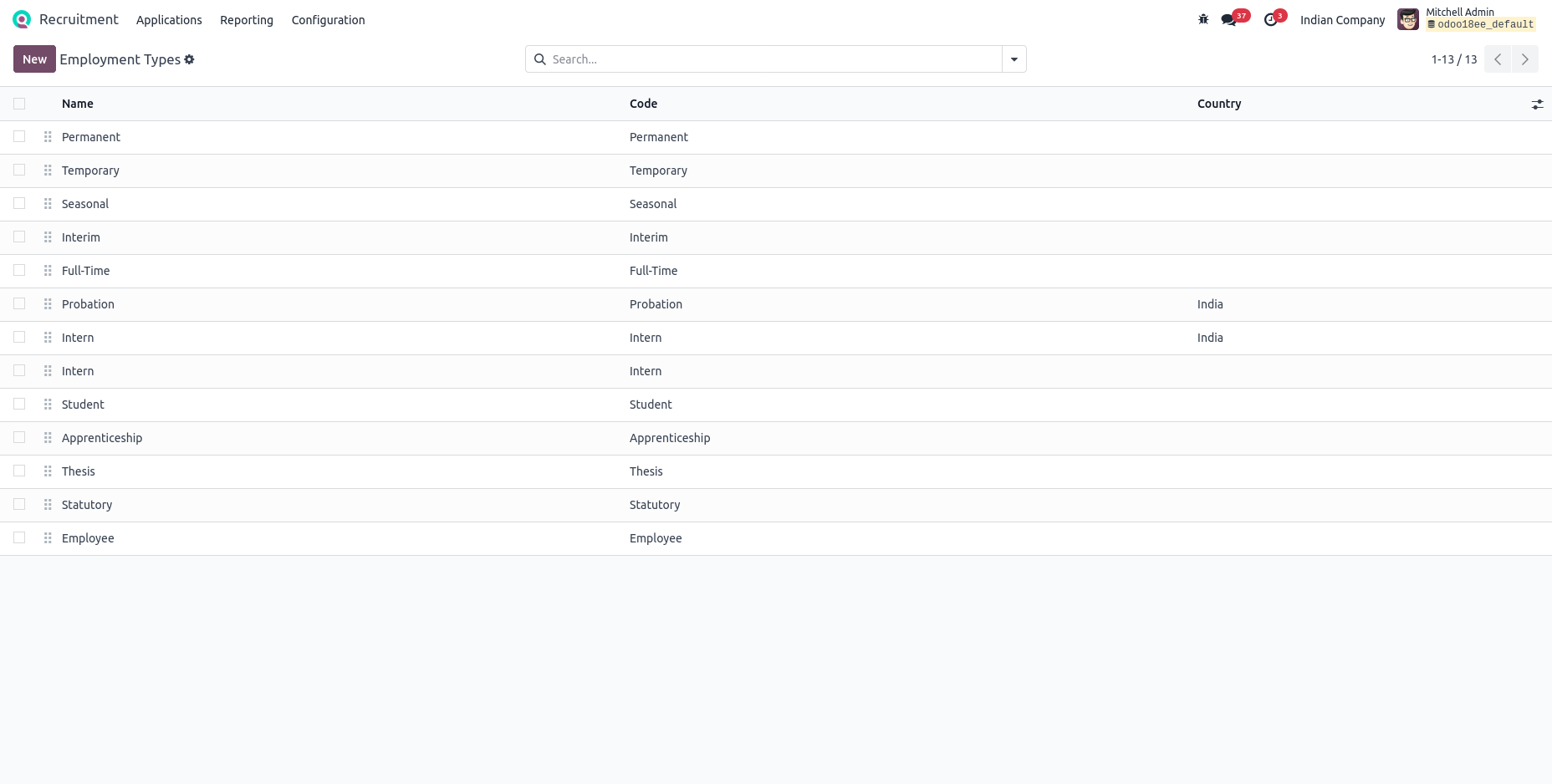
Sources
Overview
In Odoo Recruitment, Sources represent the origin or channel through which a candidate discovered or applied for a job posting. This could include online platforms (like LinkedIn), internal referrals, recruitment agencies, or job fairs. By tracking sources, HR teams gain insights into which channels are most effective for attracting qualified candidates.
Process Flow
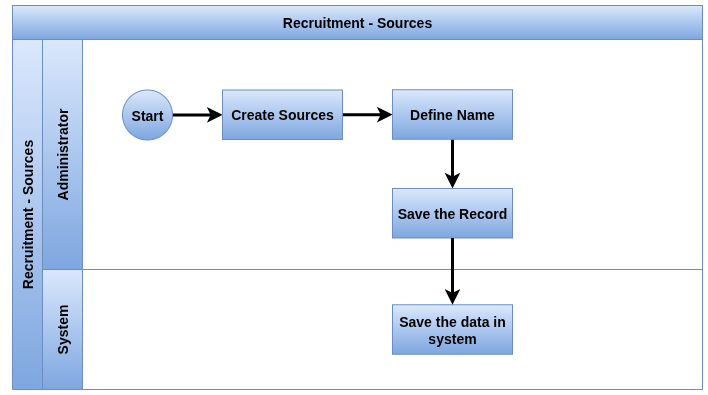
Business Rules
- The Source Name field must be mandatory
Screenshots
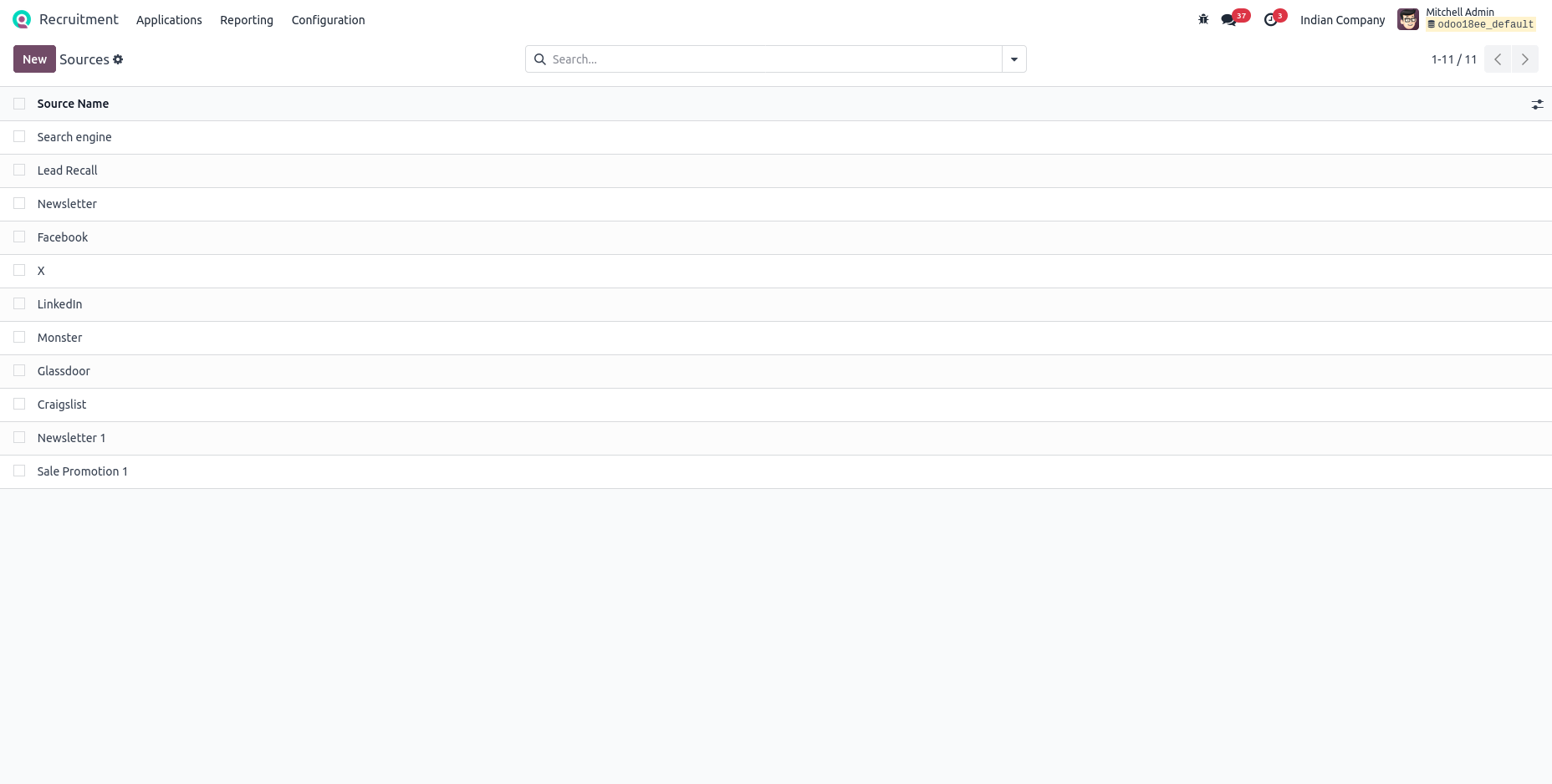
Mediums
Overview
In Odoo, particularly in the Recruitment and Marketing modules, a Medium refers to the channel or method used to deliver a job advertisement or marketing message—essentially, how a candidate arrived at a job listing, as opposed to just where they came from (which is defined as the Source). In other words, the Medium describes how the applicant found the job (e.g., Paid Ad, Email Campaign, Organic Search).
Process Flow
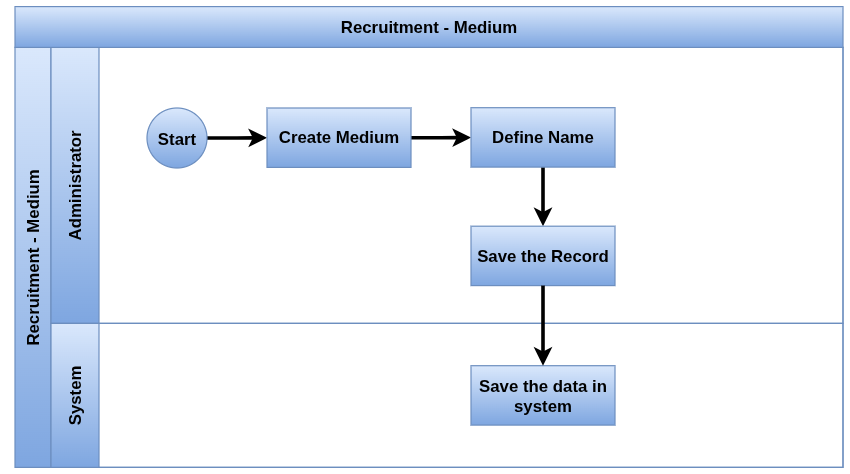
Business Rules
- The Medium Name field must be mandatory
Screenshots
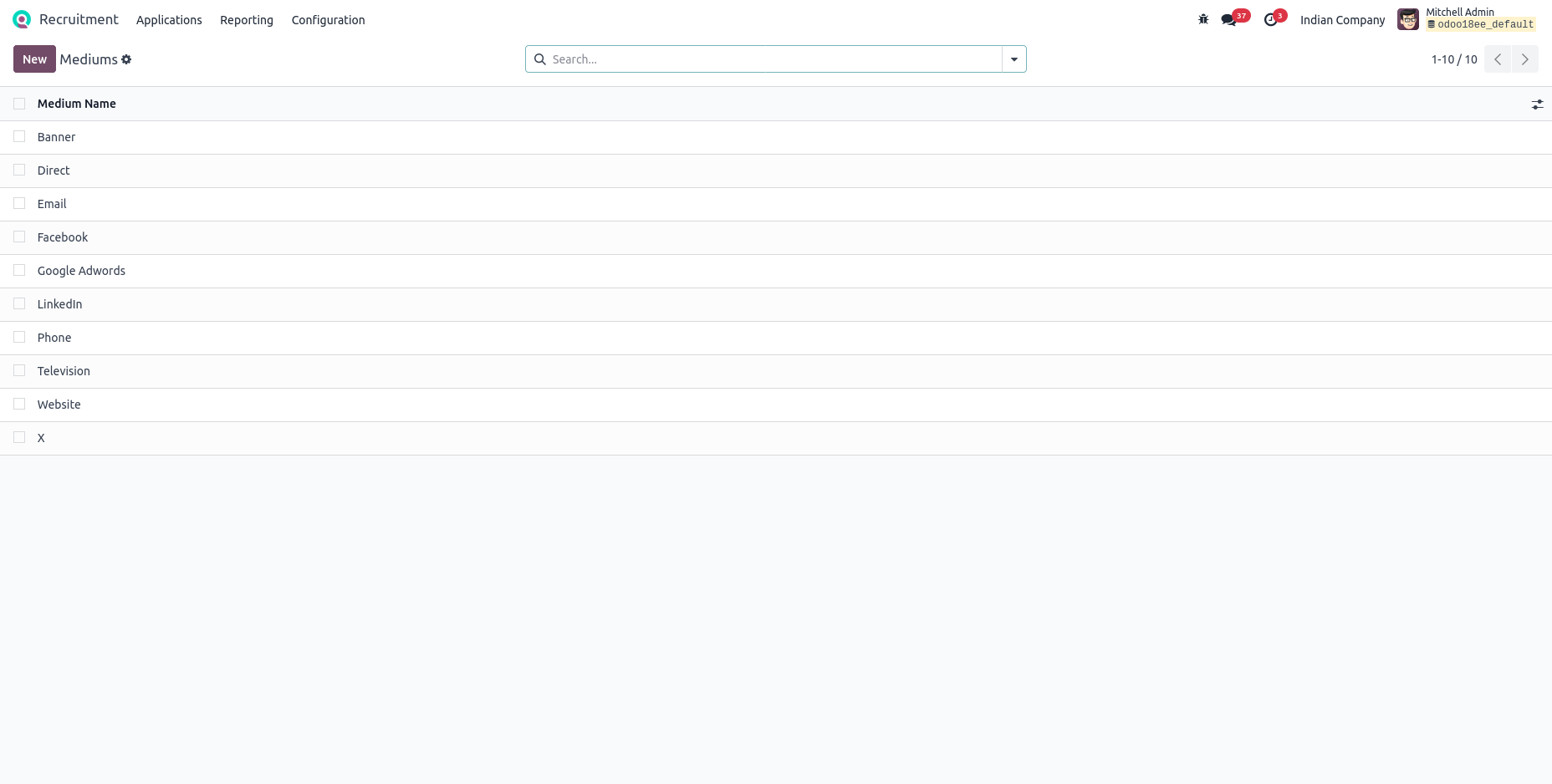
Departments
Overview
Departments organize job positions by teams or functions, like Sales or Engineering. In recruitment, they help manage applicants, clarify which part of the company is hiring, and improve reporting by department.
Process Flow
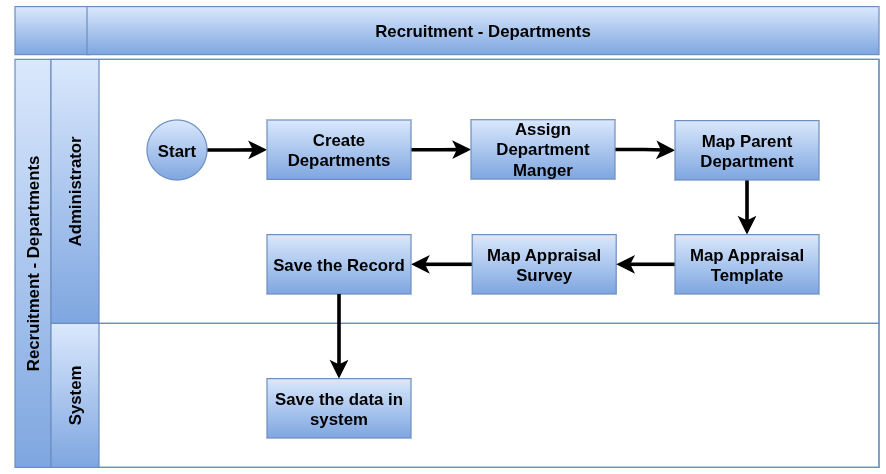
Business Rule
- The parent department list should display only departments that belong to the selected company
- When a company is selected, the default appraisal template should be automatically assigned to the appraisal template field
Screenshots
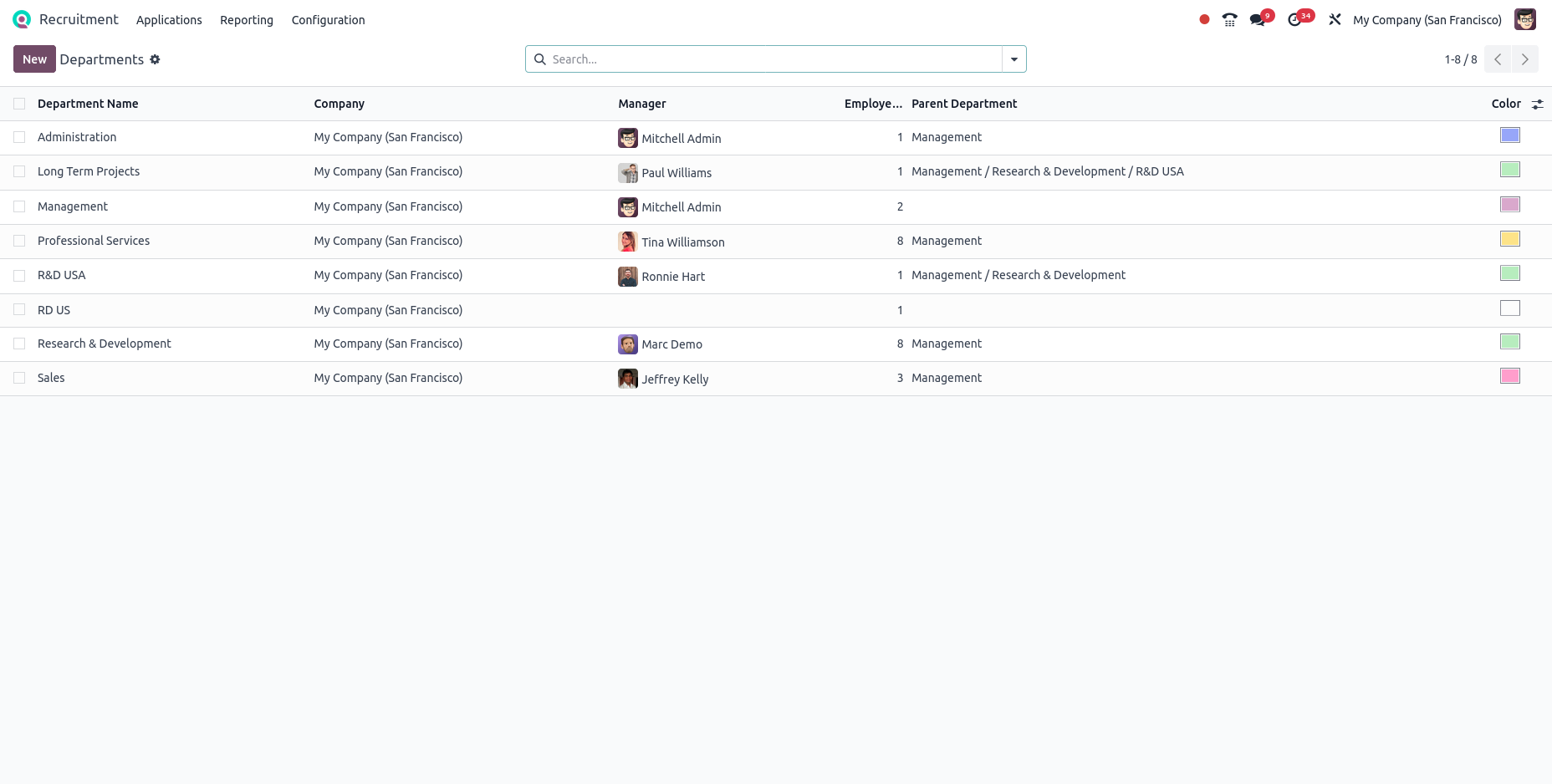
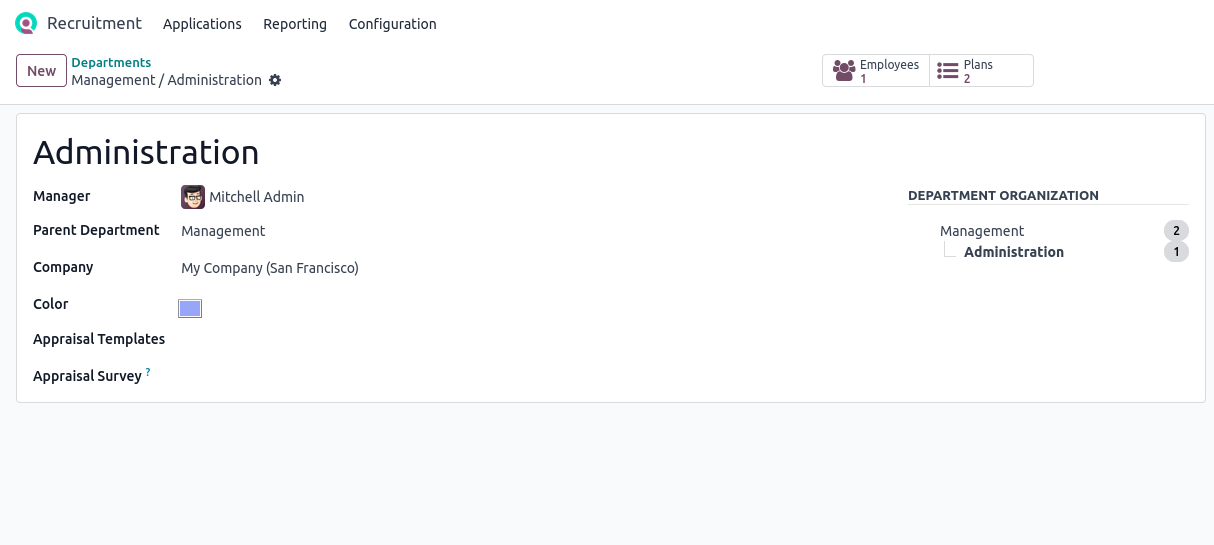
Skill Types
Overview
Skill Types categorize the different kinds of skills that candidates may possess or be assessed on during recruitment. These can be technical skills, soft skills, languages, certifications, or any other competencies relevant to job requirements.
Process Flow

Business Rules
- A Skill Types Name must be selected when create the record
Screenshots
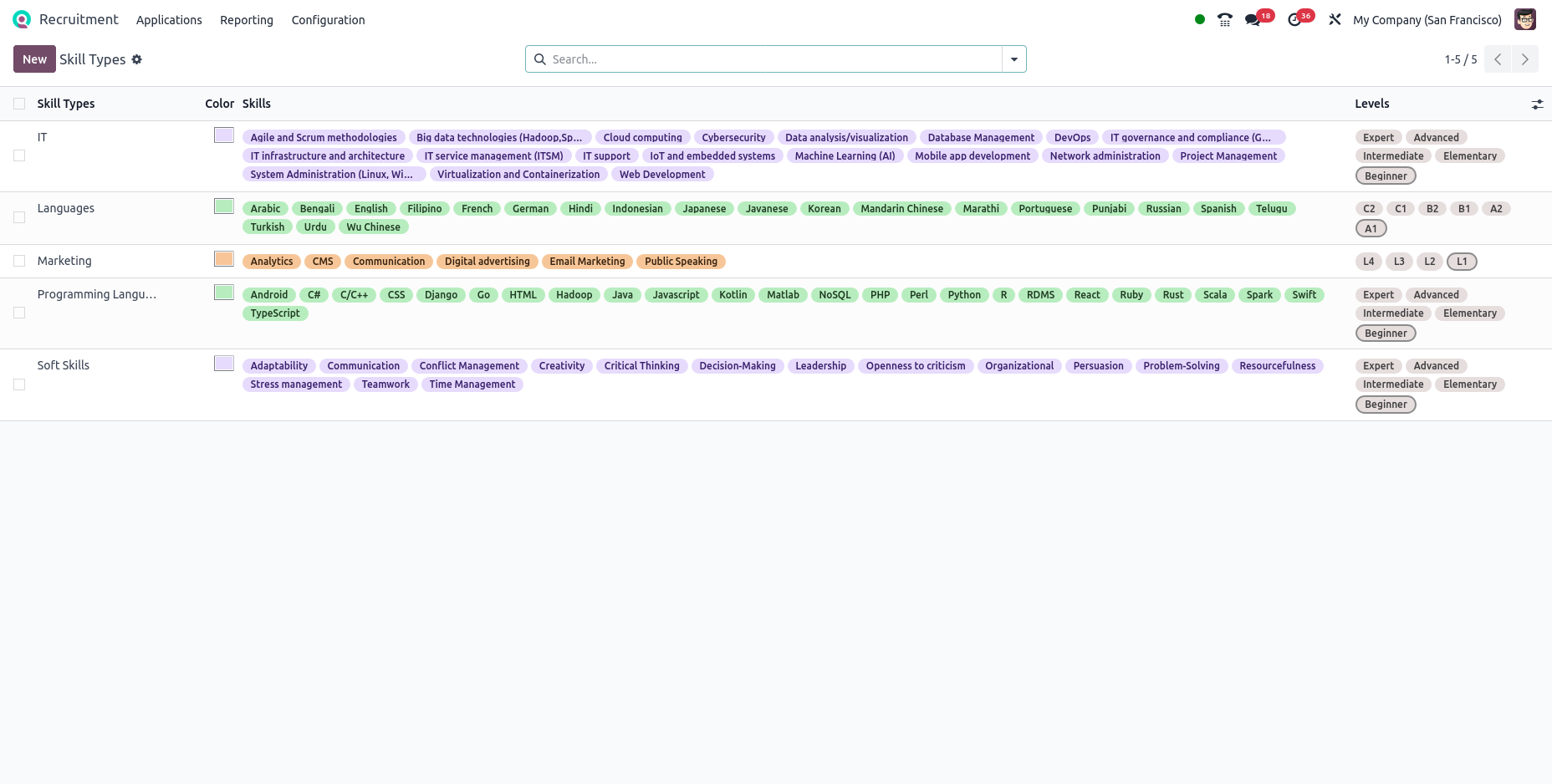
Activity Types
Overview
Activity Types define the different kinds of tasks or actions that recruiters and hiring teams perform throughout the recruitment process. These can include interviews, Email, phone calls, meetings, tests, follow-ups, Request Signature and more.
Process Flow
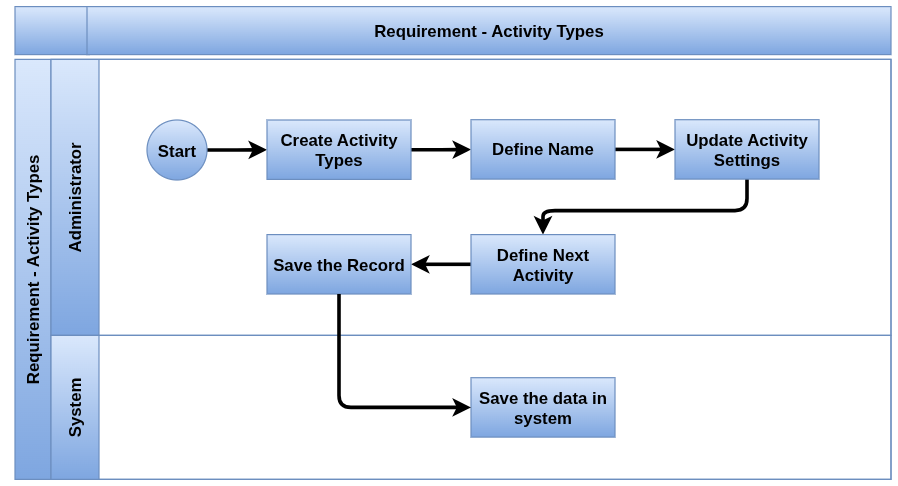
Business Rules
- A Activity Name must be selected when create the record
Screenshots
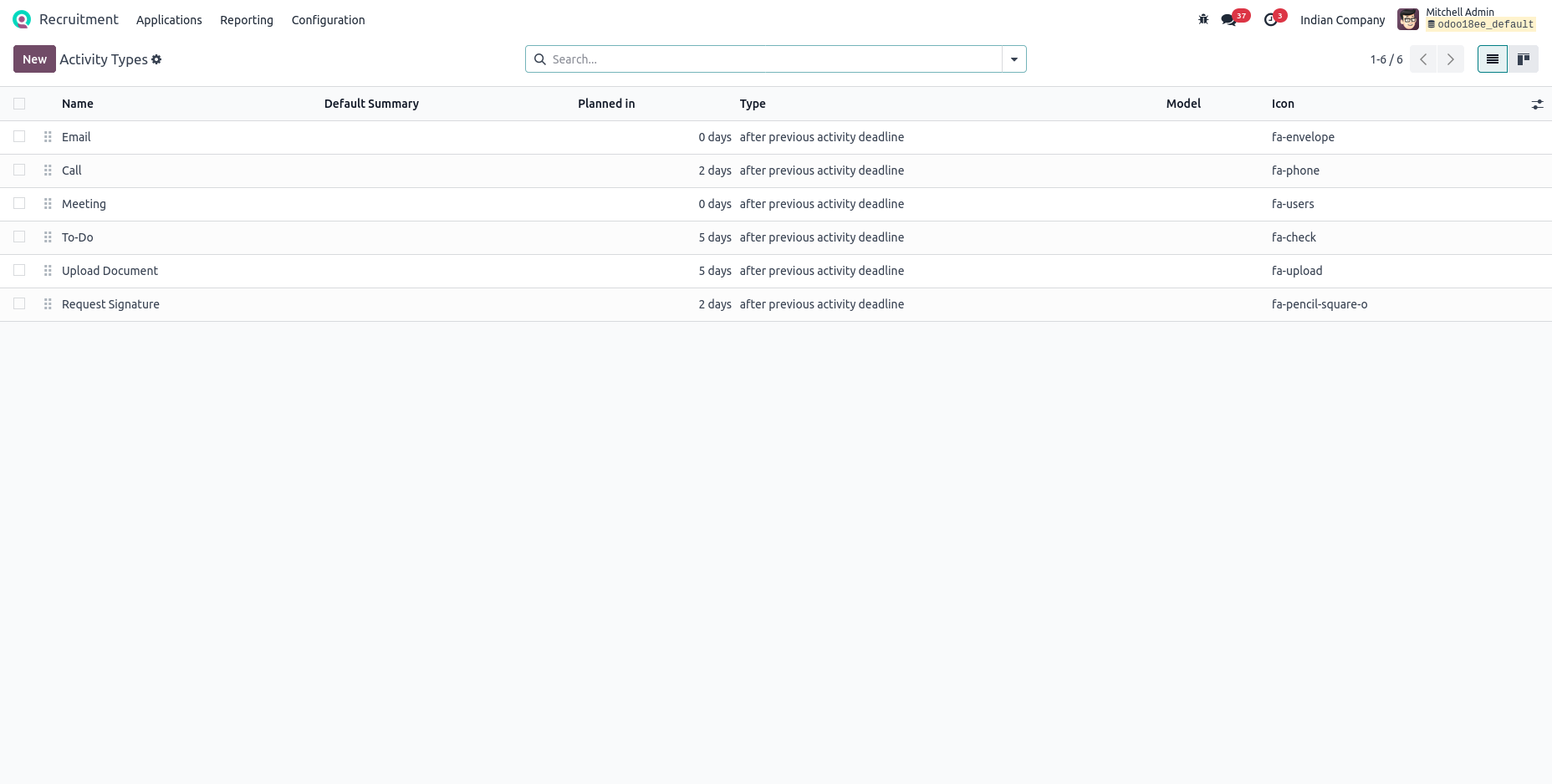
Recruitment Plans
Overview
Recruitment Plans are strategic documents or workflows that outline the process, resources, and timeline needed to fill one or multiple job positions. They help HR teams plan and coordinate hiring activities effectively to meet organizational staffing goals.
Process Flow
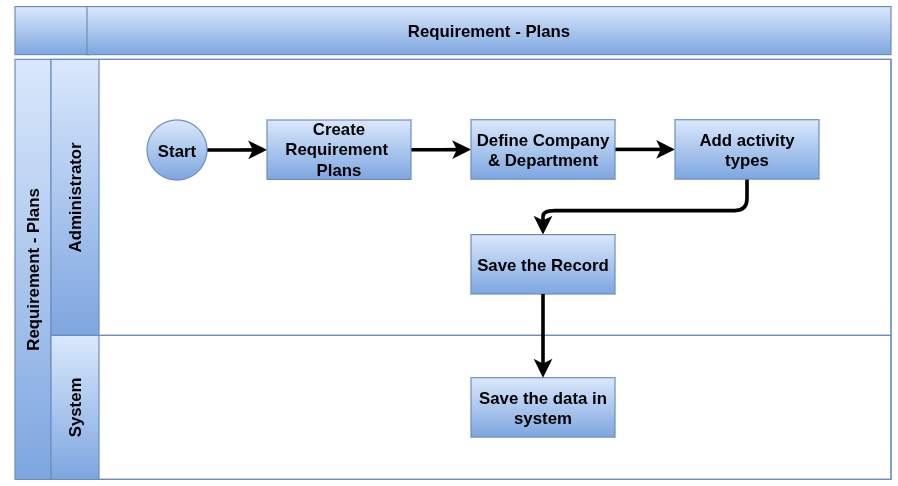
Business Rules
- Department selected based on selected company
Screenshots

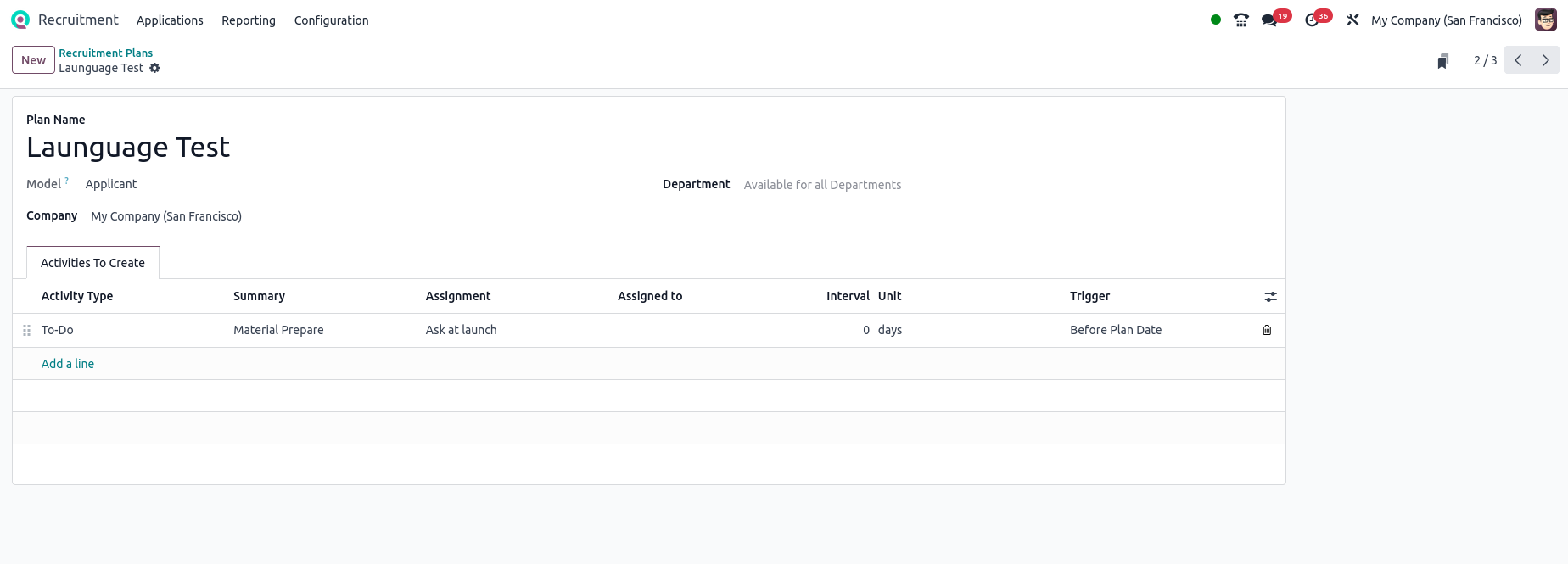
Tags
Overview
Tags are customizable labels used in the Recruitment module to categorize, filter, and organize job applicants. They help recruiters quickly identify key attributes, statuses, or qualifications of candidates at a glance.
Process Flow
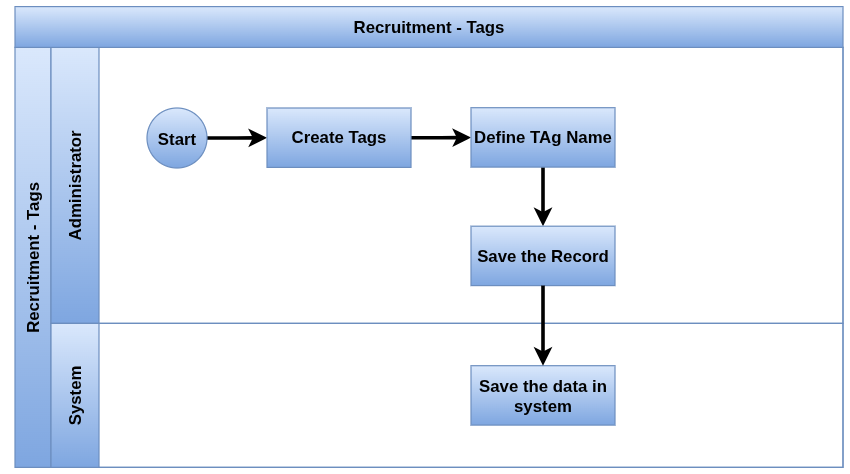
Business Rules
- A Tag Name must be selected when create the record
Screenshots:

Recruitment Management
Following are the list of Recruitment features supported by Odoo,
- Job Position and Publishing
- Receive Application
- Send Recruitment Survey
- Schedule Interview Meeting
- Applicant Self-Scheduled Interview
- Job Offer
- Refuse Applicants
Job Position and Publishing
Overview
Creating a job position involves defining the job title, department, description, requirements, and recruitment stages. This setup enables recruiters to publish vacancies, manage applications, and customize the hiring workflow for each role.
Process Flow
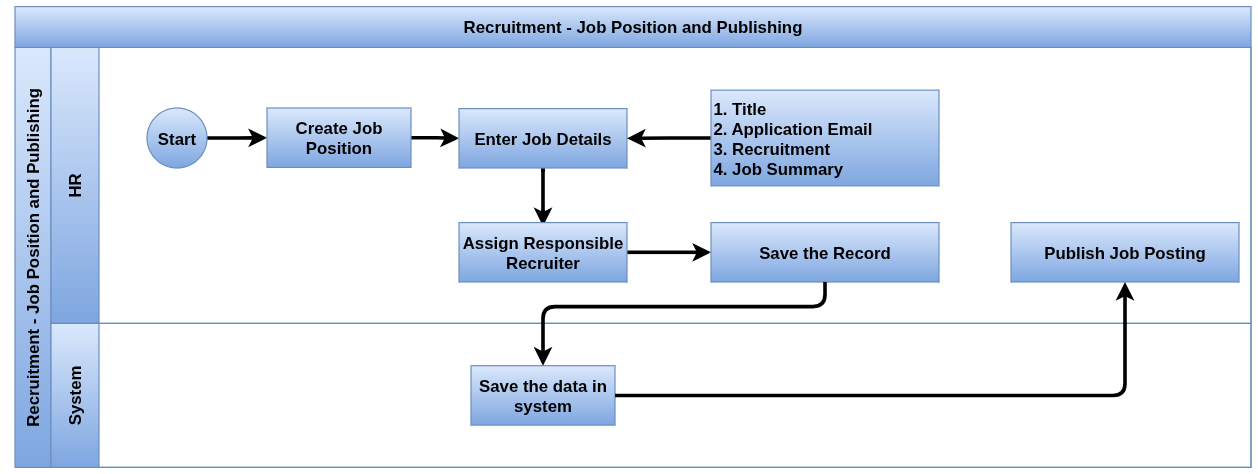
Business Rules
- Job Title, Department, and Recruitment Stages must be filled before saving
- Job titles must be unique within the same department
- Only users with HR Manager roles can create or publish job positions
- At least one recruitment stage must be defined before publishing a position
- Every job position must have an assigned responsible recruiter or manager
- Job positions must be marked as “Recruitment Ready” before being published online
Screenshots
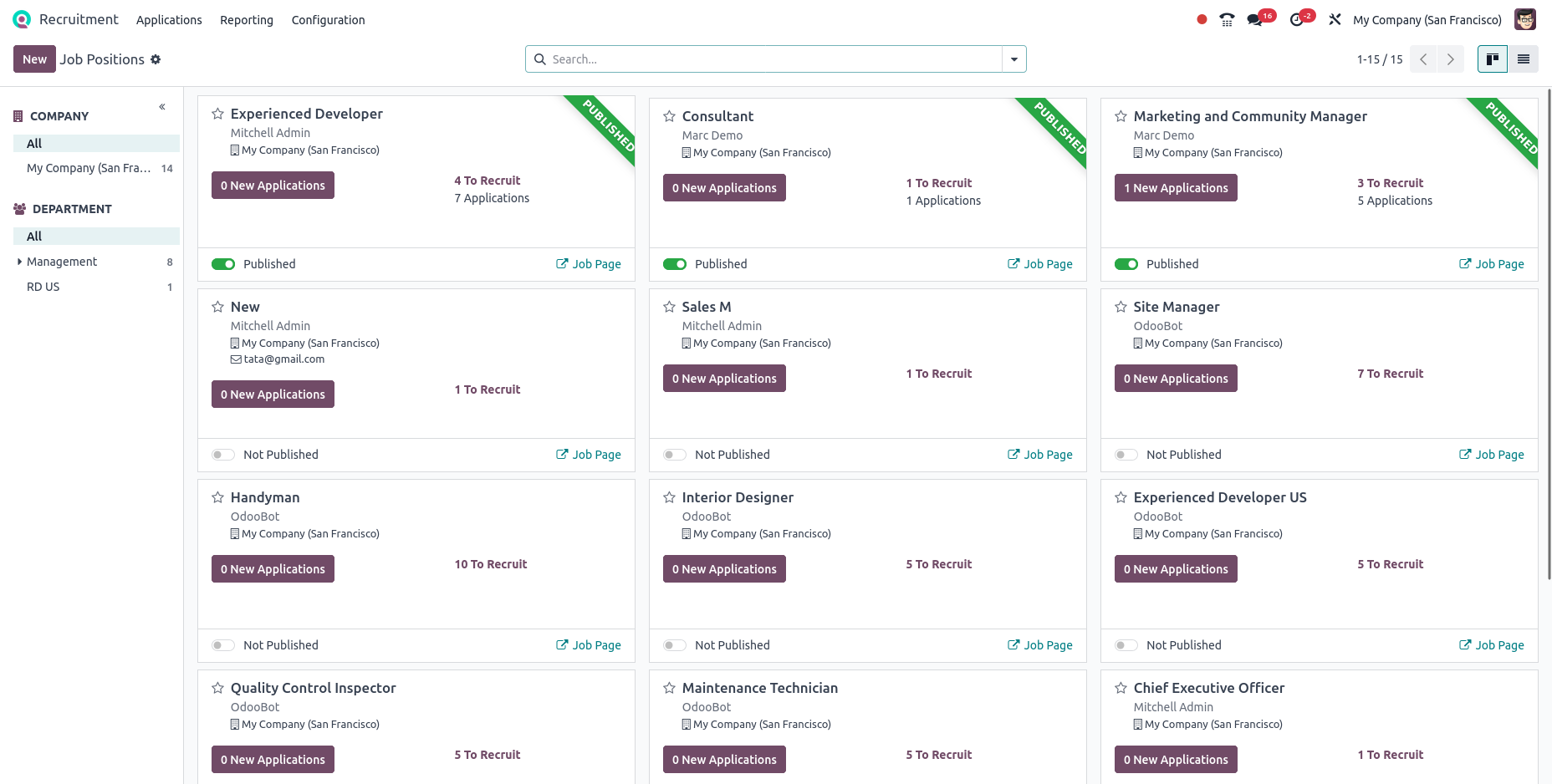
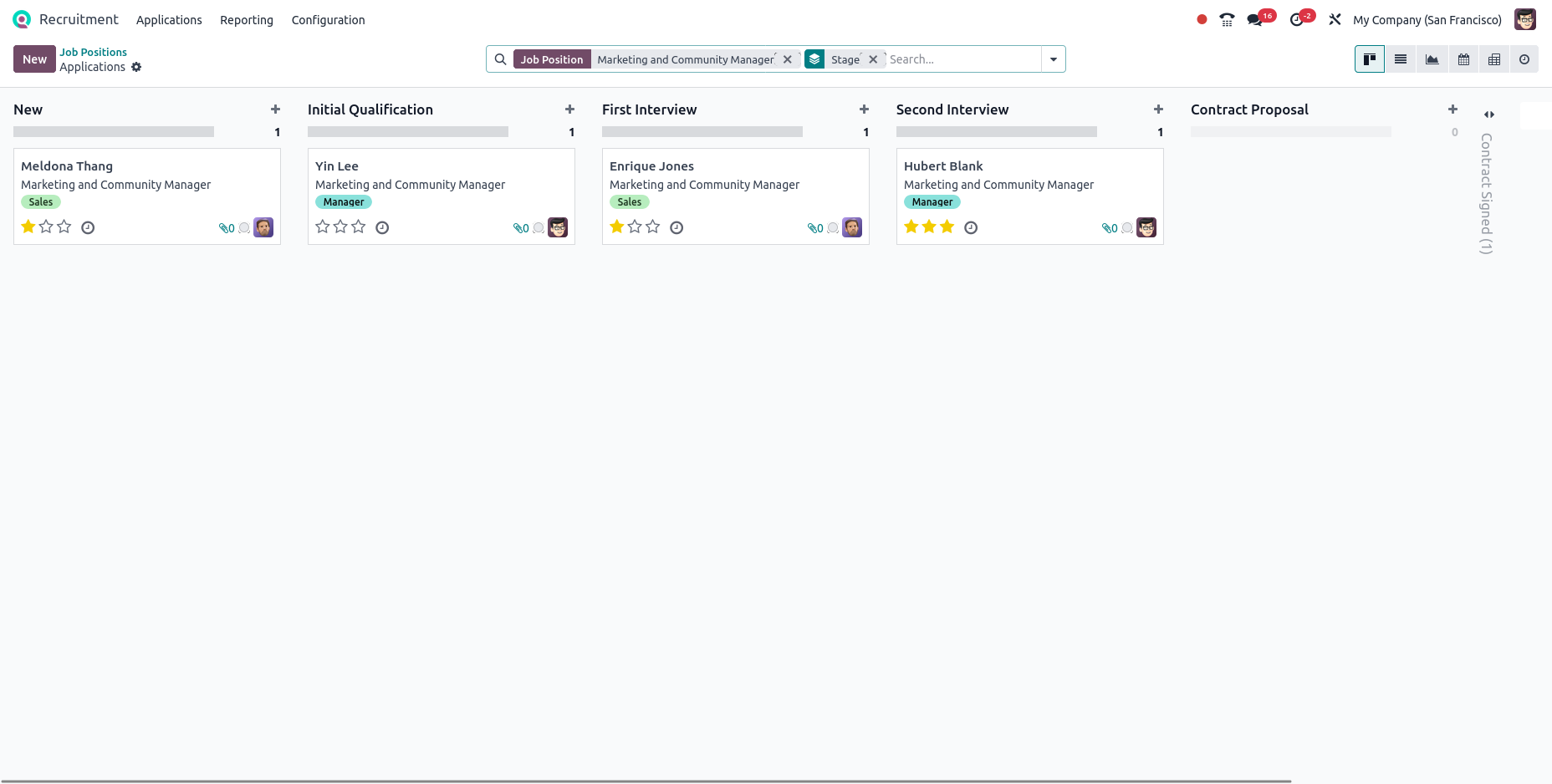
Receive Application
Overview
System automatically collects candidate applications submitted via the company website or job-board emails. It creates candidate profiles, attaches resumes, and links applications to job positions. HR teams can then review, filter, and manage these applications efficiently within the system. Automated emails acknowledge receipt, ensuring timely communication with candidates.
Process Flow
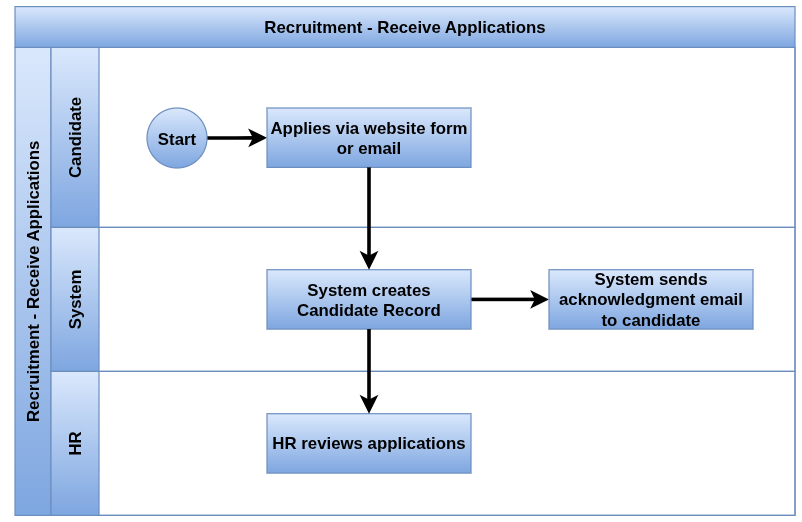
Business Rules
- Applications must be linked to an active job position
- Candidate records are automatically created when applications are received via the website or designated email aliases.
- An acknowledgment email must be sent automatically upon receipt of every application.
- Only HR or recruiters with proper permissions can access and manage received applications.
- Candidates rejected during initial screening must receive a rejection email automatically
Screenshots
Applications By Job Positions
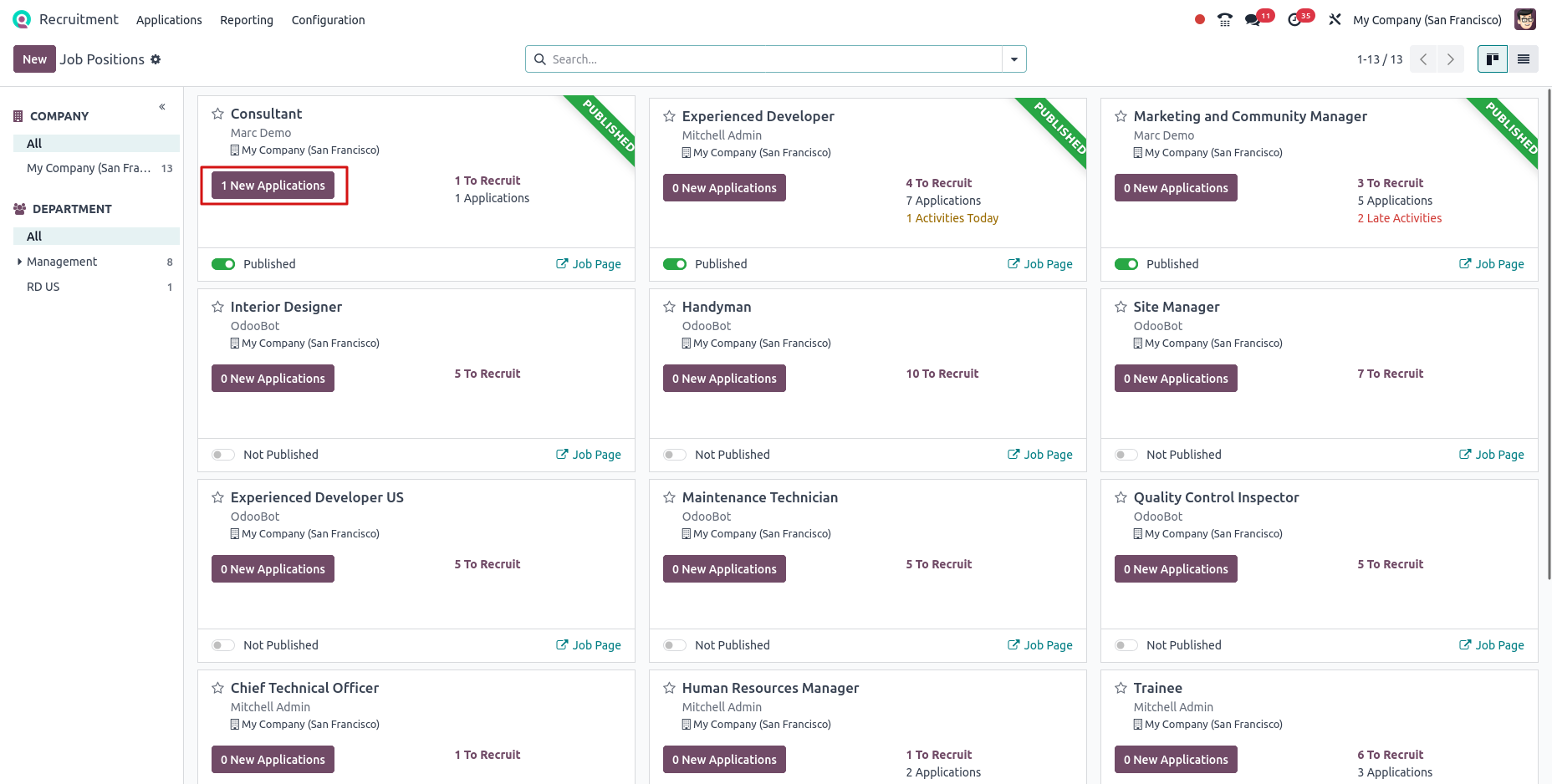
All Applications View
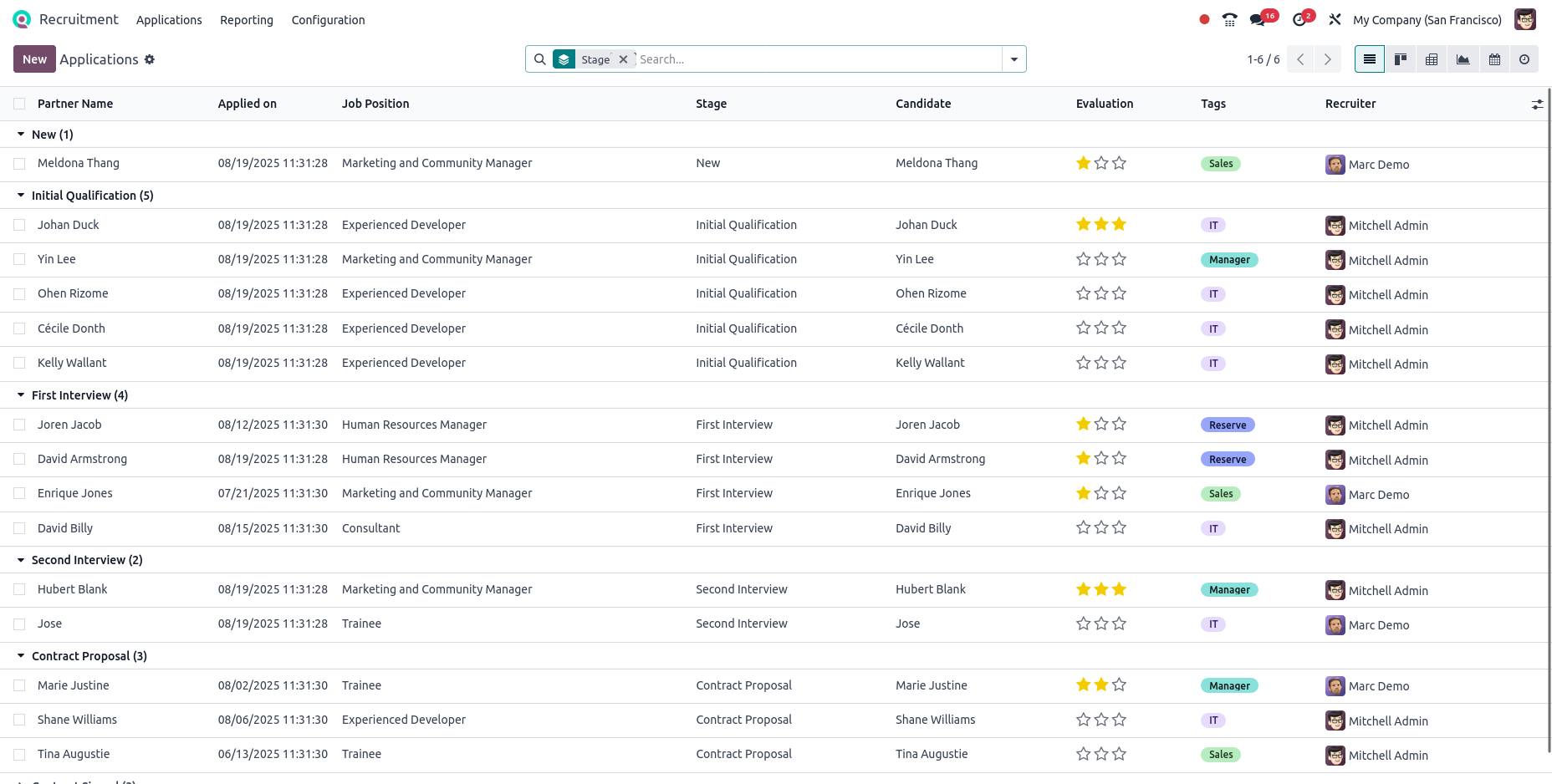
Send Recruitment Survey
Overview
Send recruitment surveys to applicants directly from their profiles. After selecting an applicant, click “Send Survey,” choose a predefined survey (e.g., skill assessment or personality test), and send it via email. Responses are automatically recorded and linked to the applicant’s profile for easy evaluation.
Process Flow
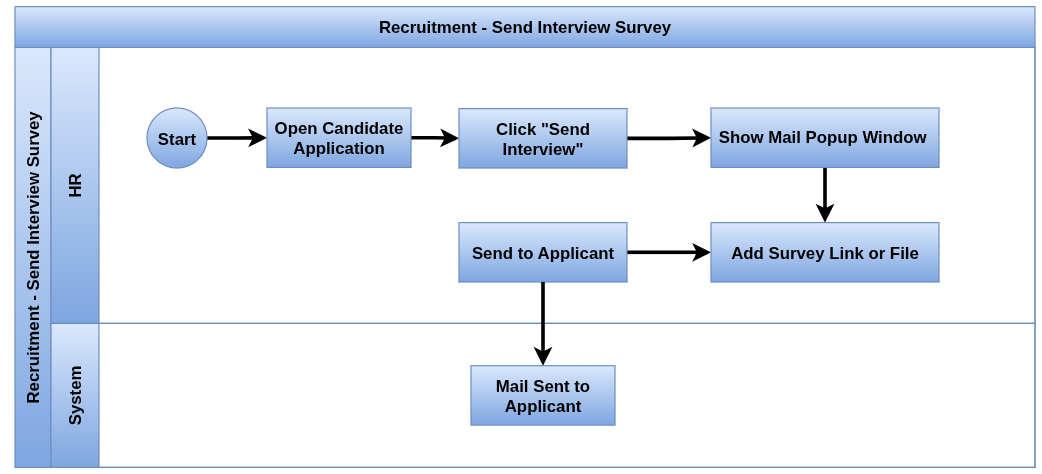
Business Rules
- An email address is mandatory to send a survey/interview
- Interviews are sent by clicking “Send Interview” from within the applicant’s detailed view
- Only contacts saved in the database can be selected in the Recipients field
- For recipients not in the database (and not to be added), use the Additional emails field
- An optional deadline (date and time) can be specified using a calendar/time picker
Screenshots
Send Interview Survey in Applications
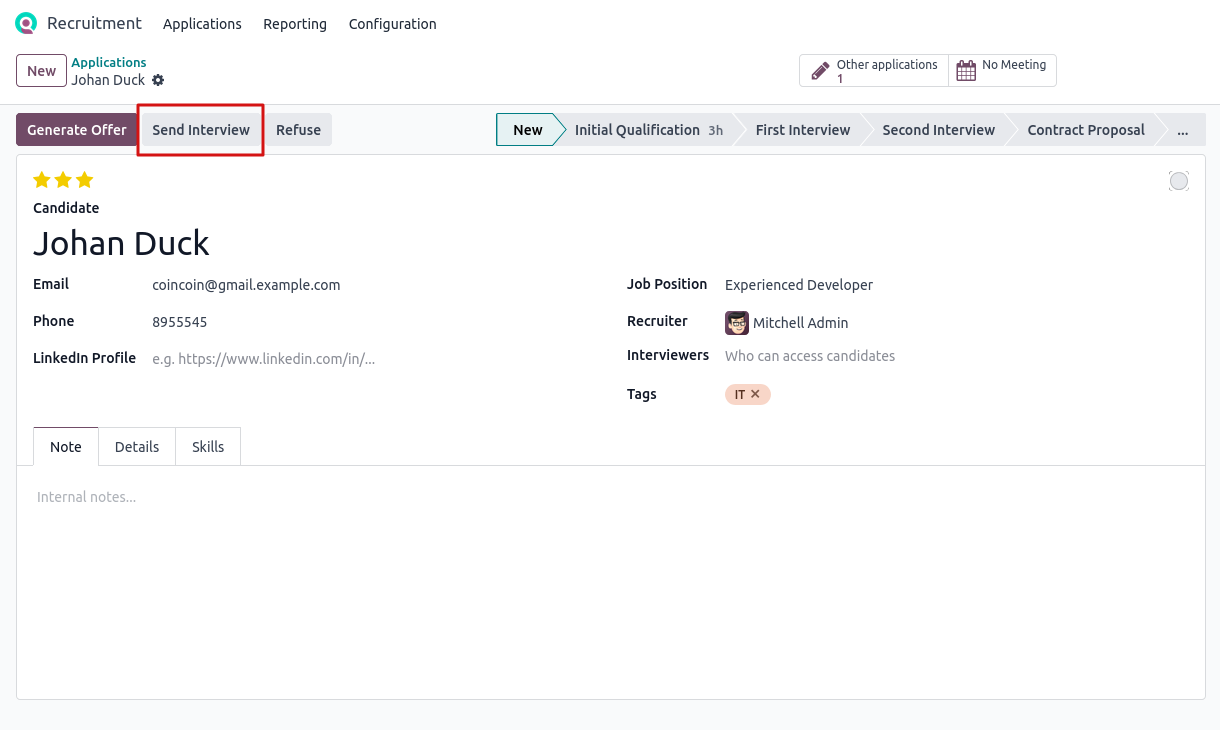
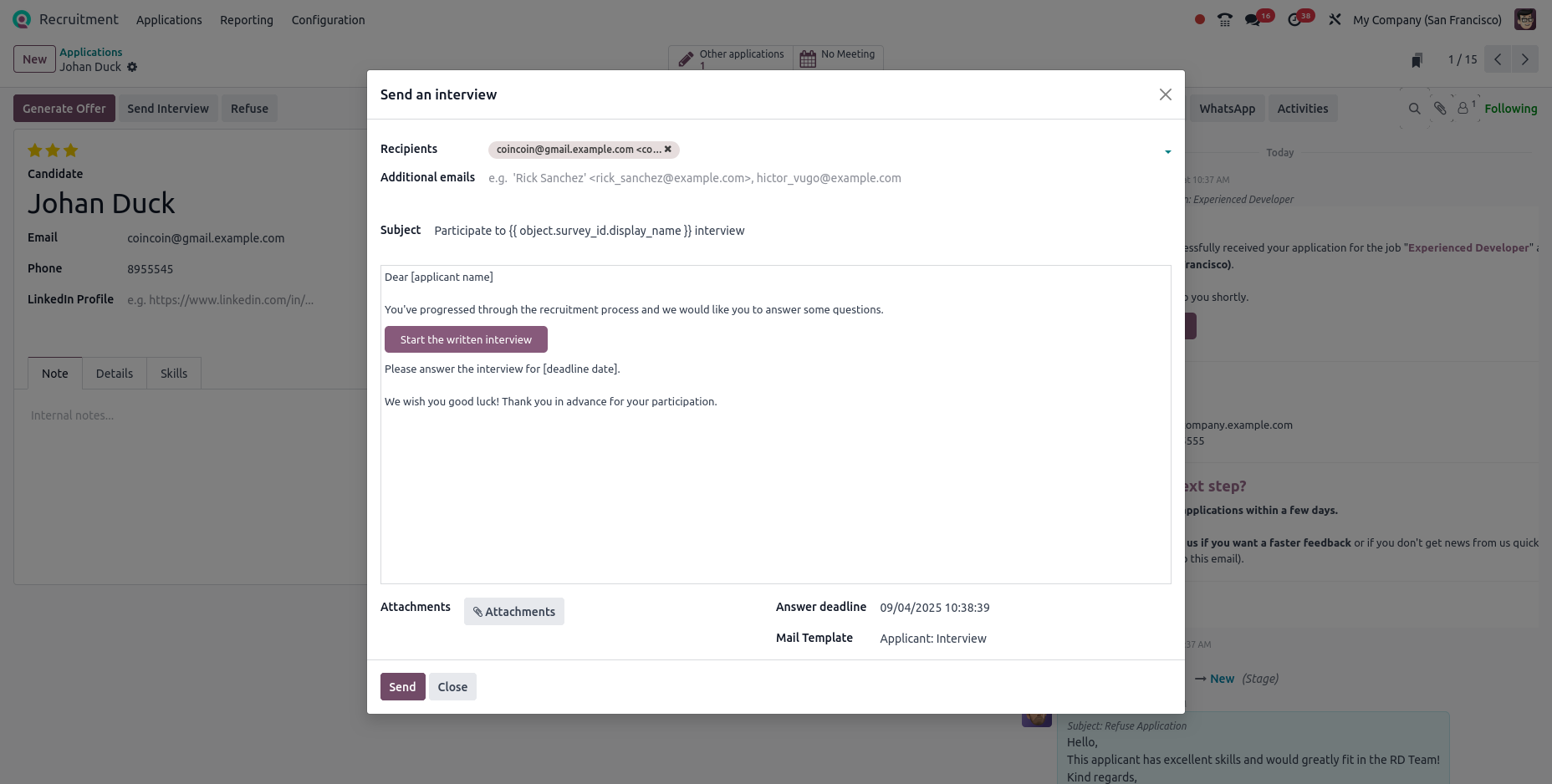
Schedule Interview Meeting
Overview
Interviews are scheduled directly from the applicant’s profile with calendar integration and automatic email invites, making the process fast and efficient. This ensures professional communication and streamlined coordination between candidates and interviewers.
Process Flow
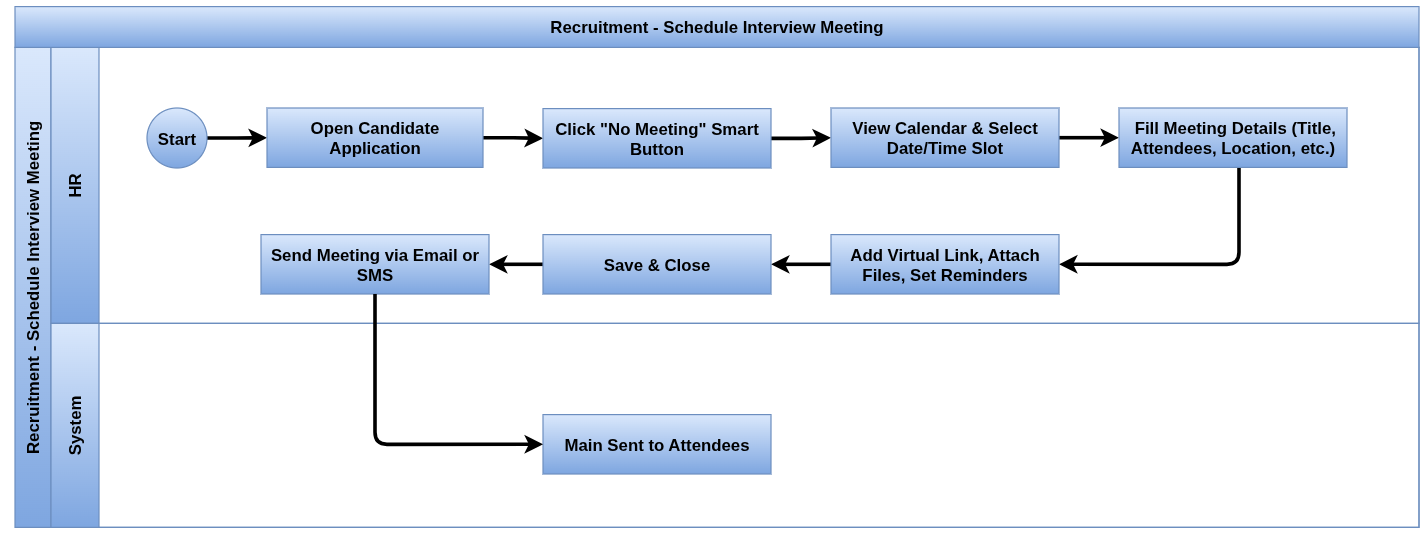
Business Rules:
- The calendar view shows meetings for selected attendees only
- Each scheduled meeting is linked to the applicant’s profile and viewable via the smart button
- Required fields for a meeting: Title, Start Date, and End Date/Time
- Virtual meetings use Odoo Meeting URLs, auto-generated with one click
- Meetings can be shared via email or SMS – SMS requires IAP credits
- Meetings can be scheduled manually or via automation using email templates
- Meeting Subject Initially auto load based on Applicant name
- Timezone will be shown once the recurrent is enabled
Screenshots
No Meeting smart button
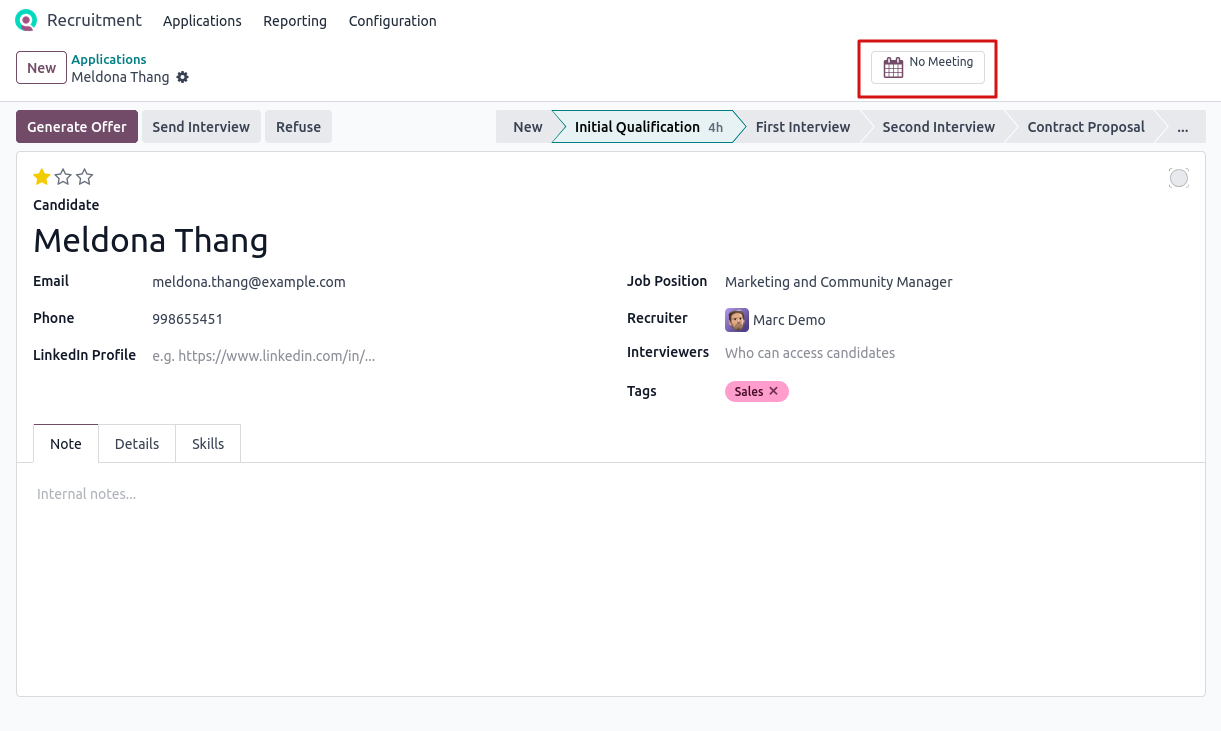
Calender View
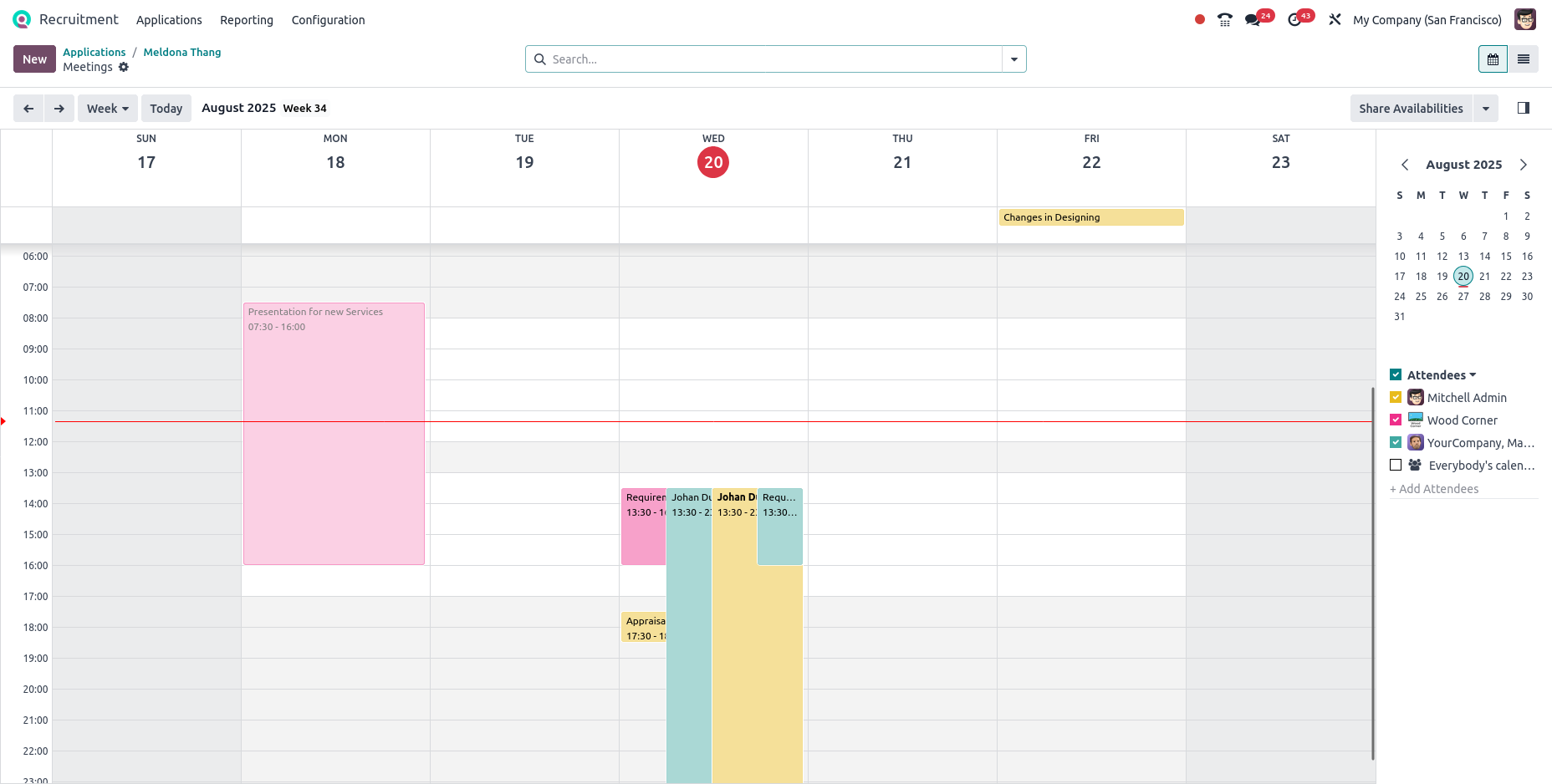
New Event View
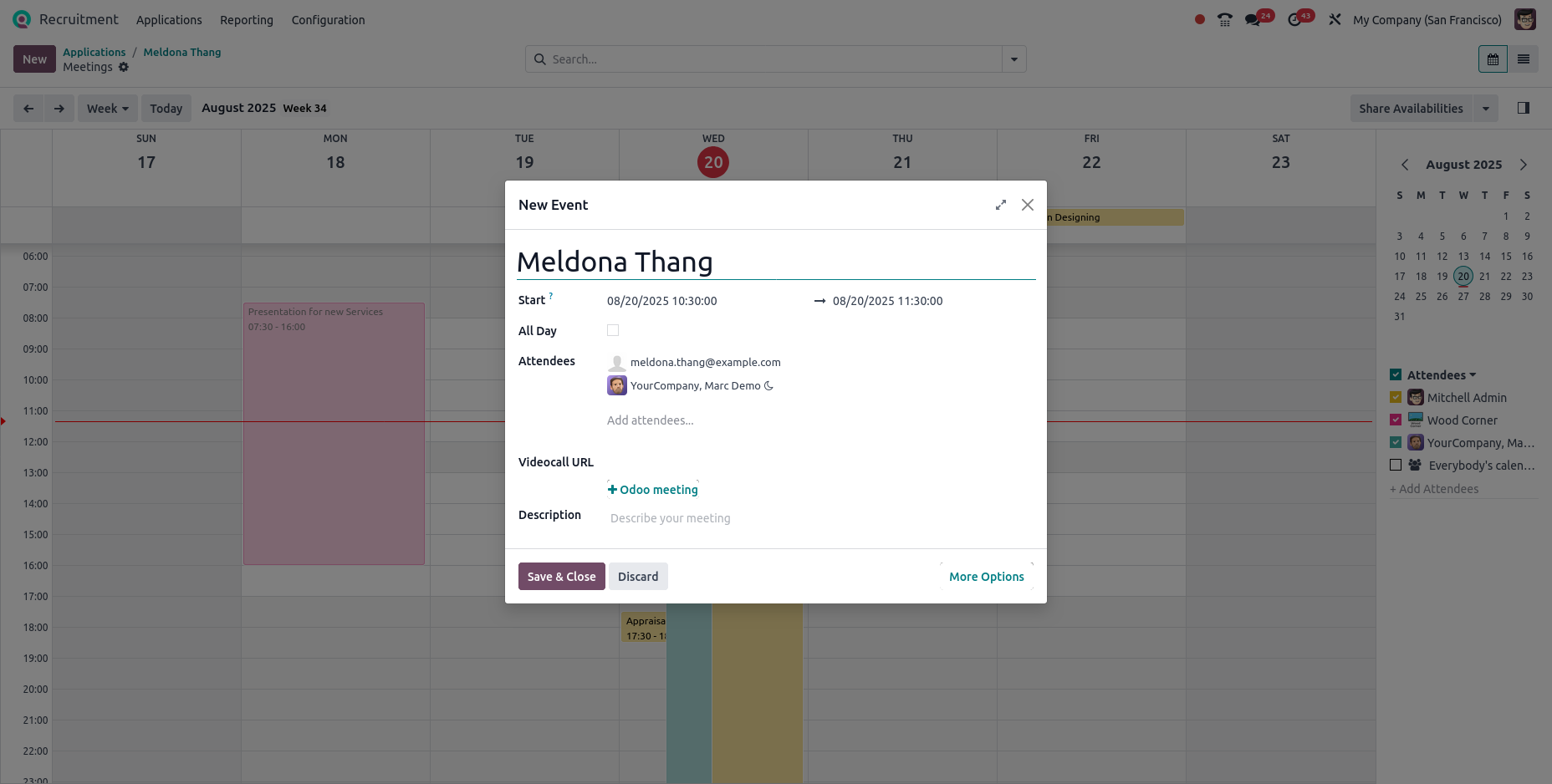
Applicant Self-Scheduled Interview
Overview
Applicants can self-schedule interviews through an automated email containing a scheduling link. After the recruiter configures the interview stage with the appropriate email template, applicants receive the link, select a suitable date and time, provide their contact details, and confirm the appointment. This streamlines scheduling by automatically updating calendars and reducing back-and-forth communication.
Process Flow

Business Rules
- The email template “Recruitment: Schedule Interview” must be assigned to the interview stage for automation
- When an applicant enters that stage, Odoo automatically sends a self-service scheduling email
- The timezone field must be accurate, as it affects the available time slots
- Applicants must provide their name, email, and phone number before confirming the appointment
- Applicants select only available time slots based on interviewer calendar availability
Screenshots
Email Generated View
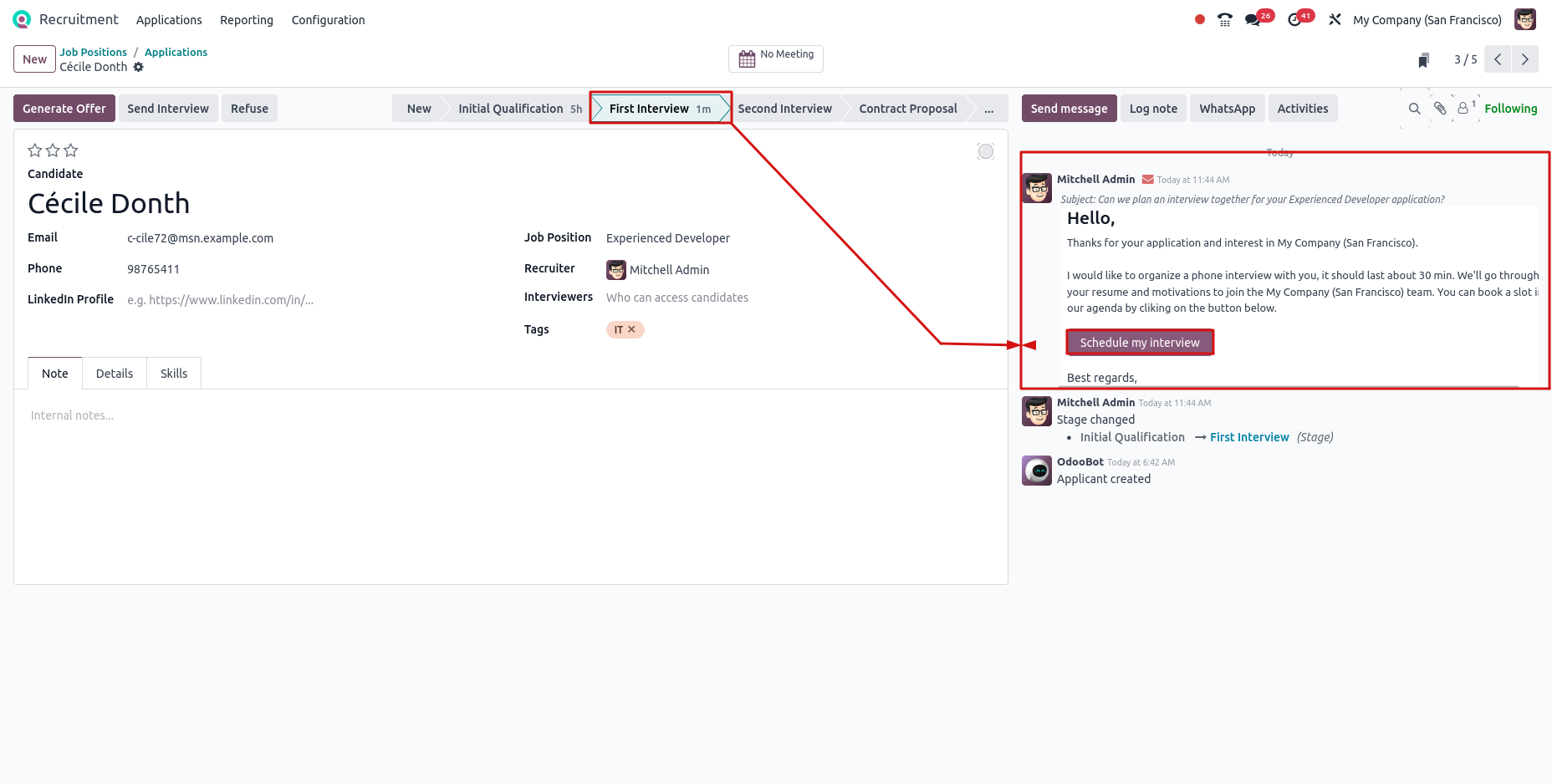
Slot Selection
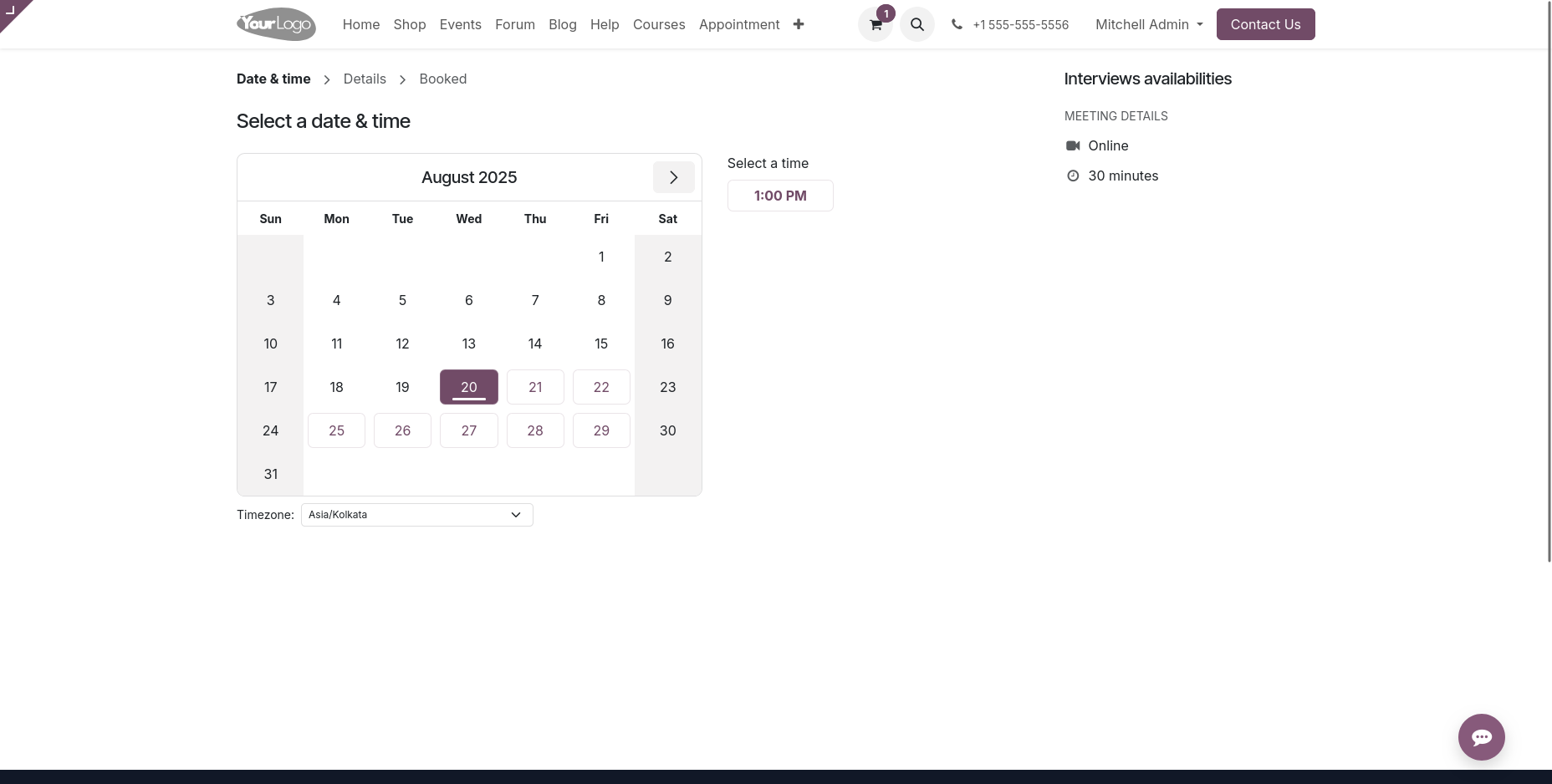
Confirm Appointment

Job Offer
Overview
The Job Offer allows you to extend a formal offer to a selected candidate by choosing an offer template, customizing details (like salary and start date), and sending it via email. The system then tracks the candidate’s response, updating their status accordingly.
Process Flow
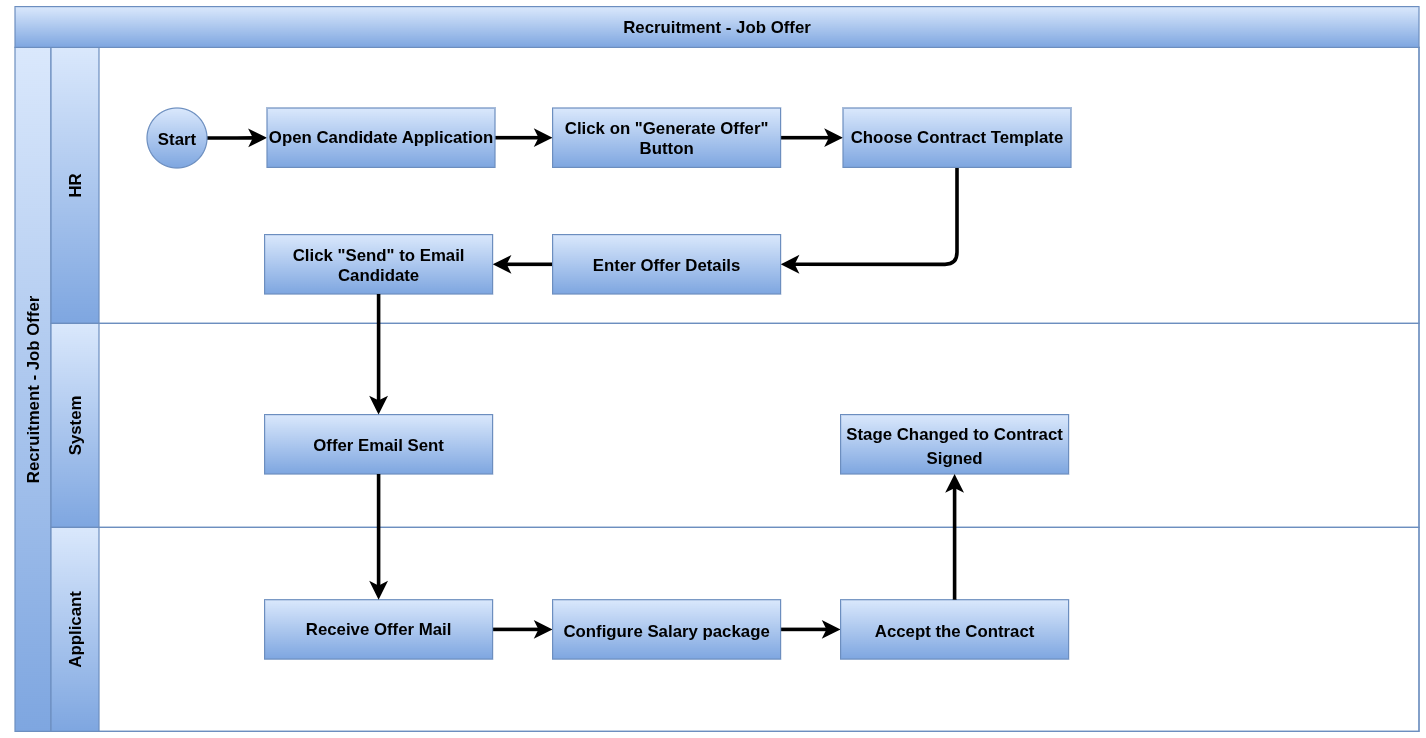
Business Rules
- An email address must be present on the applicant’s card to send an offer
- Move the applicant to the Contract Proposal stage before sending the offer
- Set the Validity Days Count (default is 30 days)
- To create the offer, click the Generate Offer button on the applicant’s form
- The offer must be sent via email by clicking the Send By Email button
- The applicant must click the Review Contract & Sign button to accept and sign the offer electronically
Screenshots
Generate Offer Button
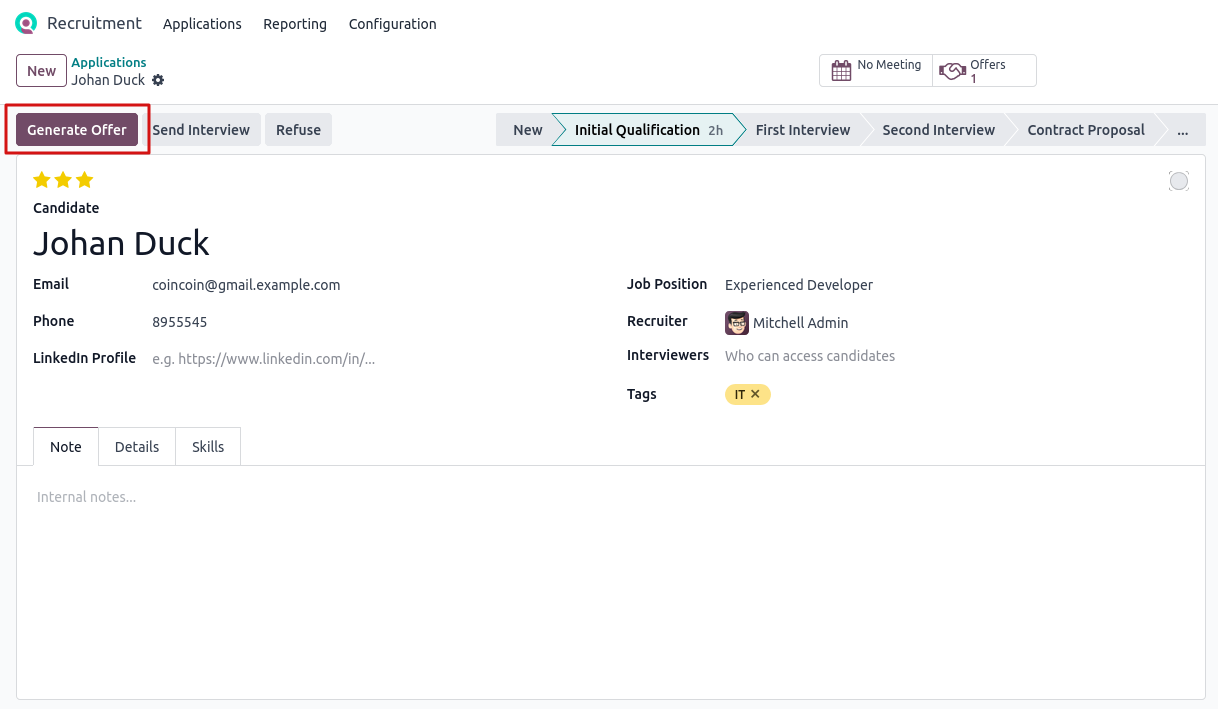
Offer Form View & Send By Email Button
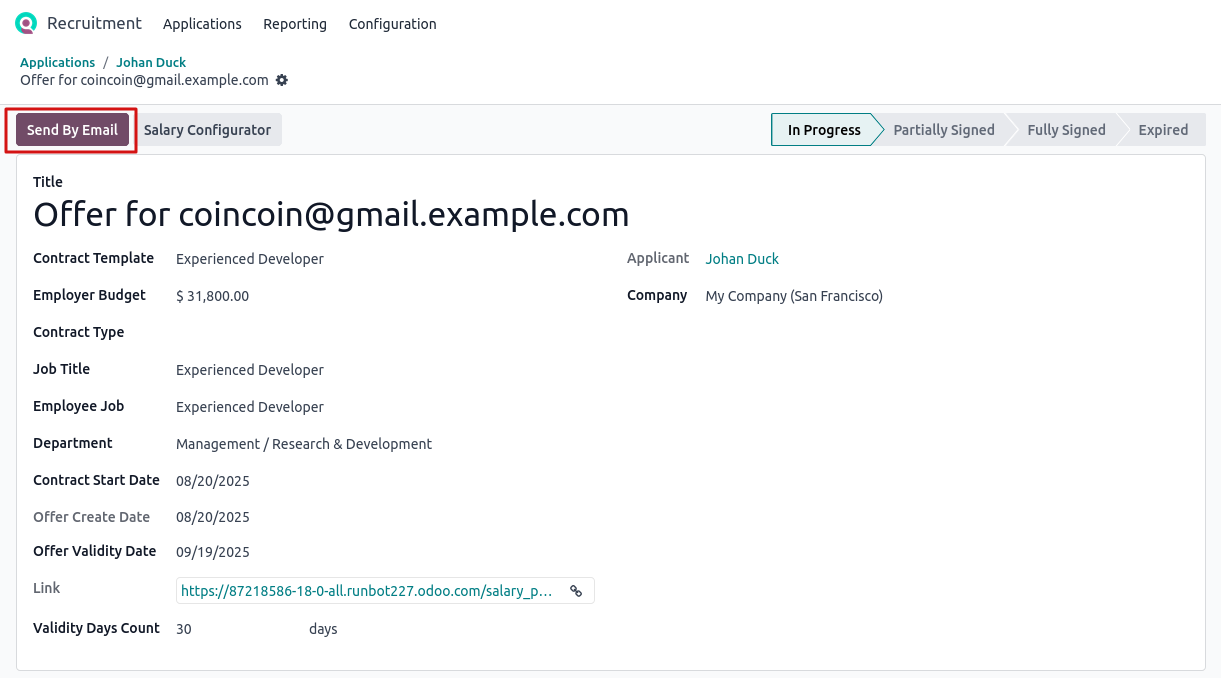
Email Popup Window
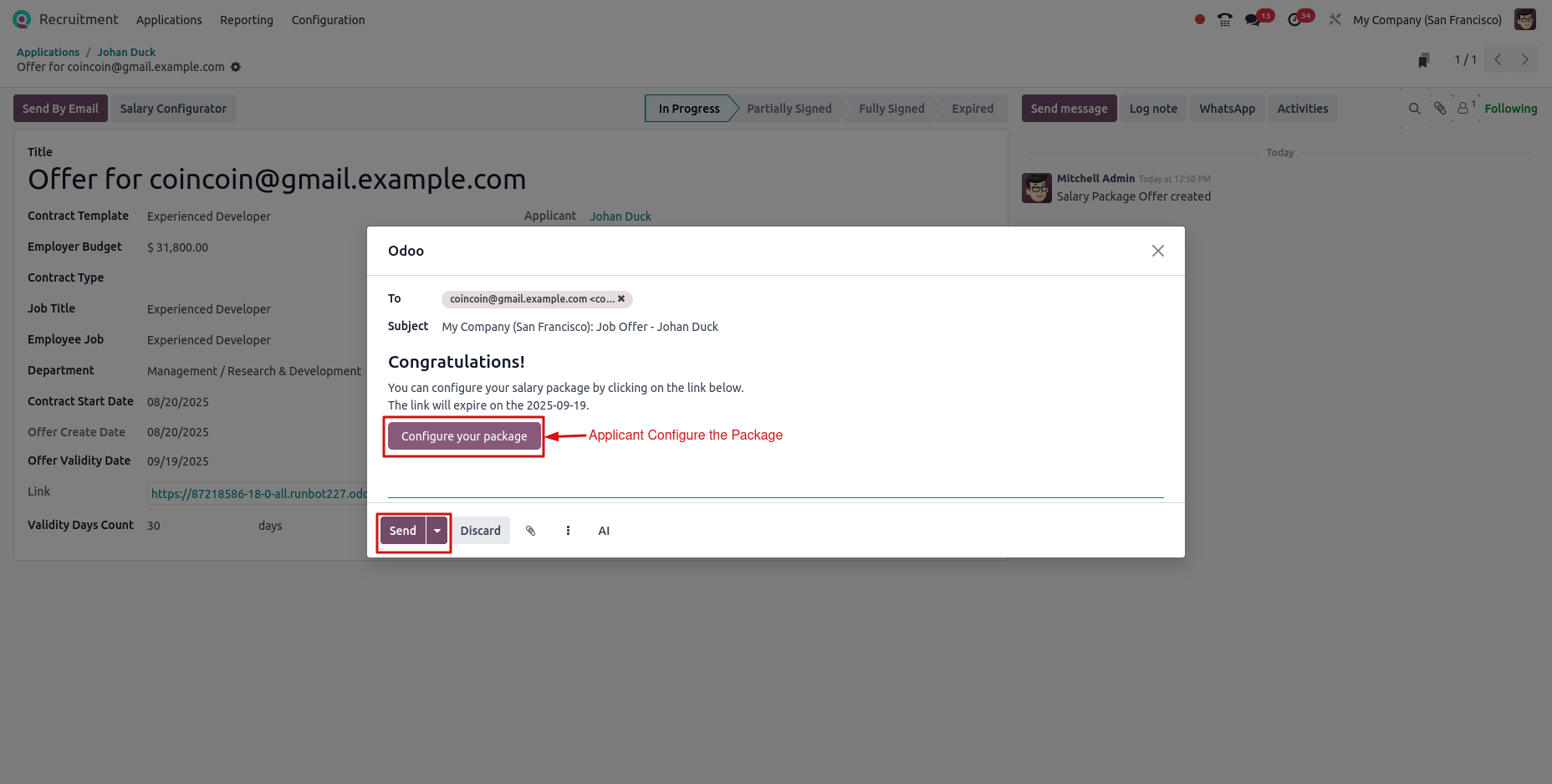
Refuse Applicants
Overview
Refuse option is used to refuse applicants at any stage of the recruitment process. Refusing an applicant involves selecting a refusal reason, sending a refusal email (via pre-configured templates), and updating the applicant’s status. The refusal reason helps document why the applicant was not a fit, and the system automatically sends an email to the applicant, informing them of the decision.
Process Flow

Business Rules
- The recruiter must click the Refuse button to initiate the refusal process
- A valid refusal reason must be selected from predefined reasons (or a custom reason)
- The recruiter must select the appropriate email template associated with the refusal reason
- Once the refusal is processed, a red Refused banner appears on the applicant’s card
- If the Send Email checkbox is not enabled, the email template is automatically hidden and no email is sent.
Screenshots
Refuse Button View
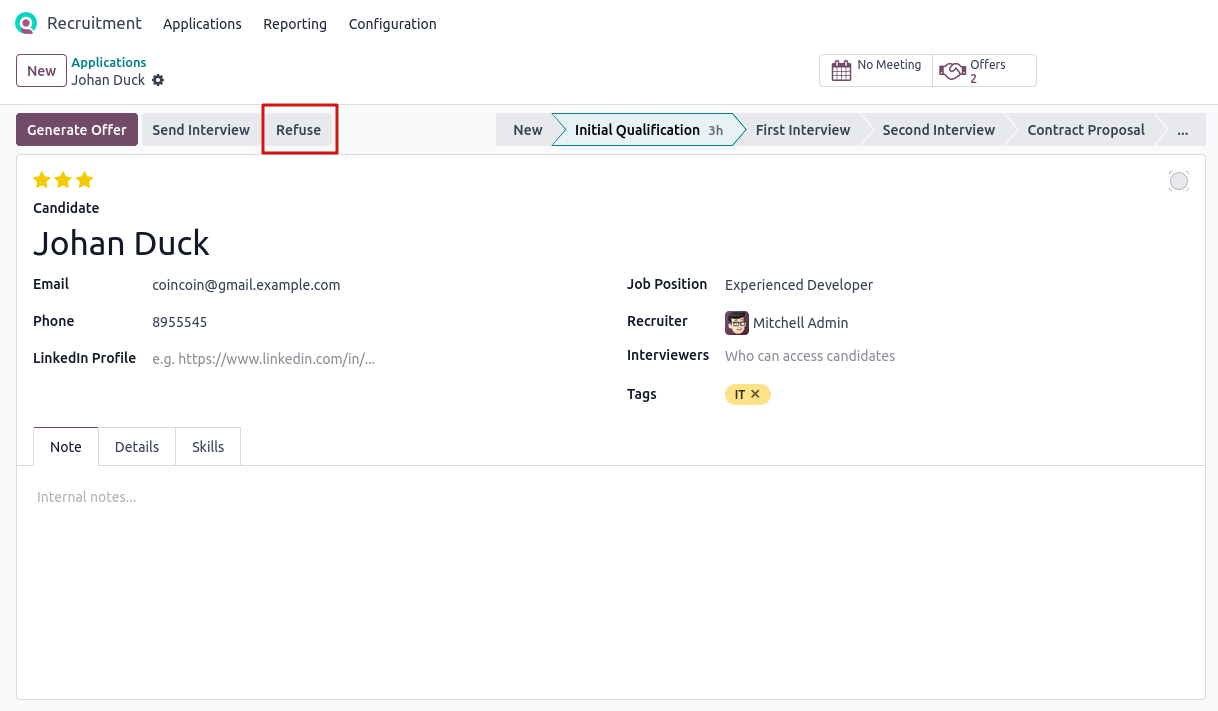
Refuse Reason Update View
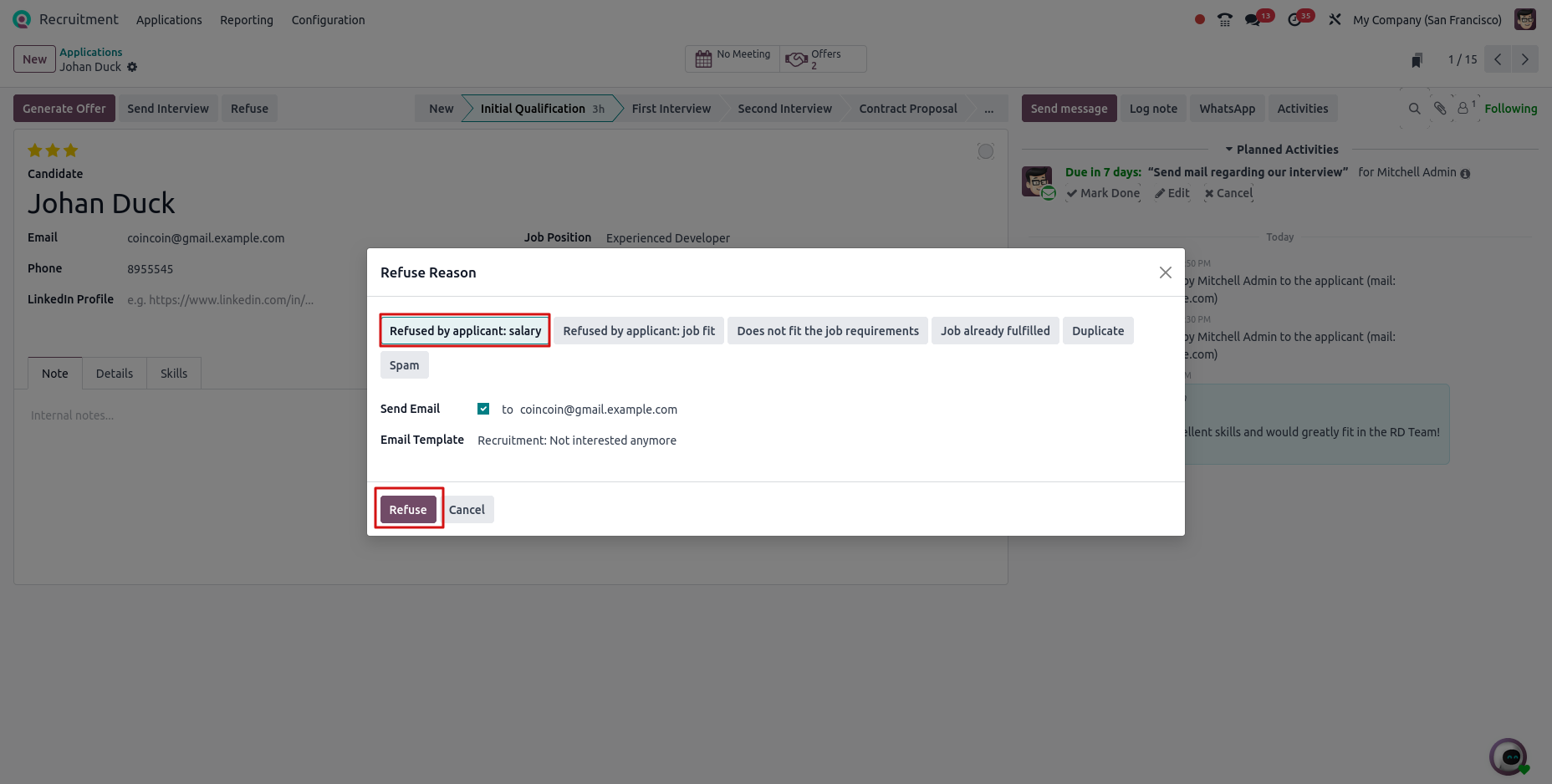
Recruitment Report Management
Following are the list of Recruitment features supported by Odoo,
- Applicant Analysis
- Source Analysis
- Velocity Analysis
- Team Performance
Applicant Analysis
Overview
The Applicant Analysis report in Odoo allows recruitment teams to analyze the effectiveness of their hiring process by providing insights into applicant trends, referral performance, and recruitment pipeline efficiency. This report visualizes applicant statistics, showing the total number of applicants, the number hired, refused, or still in progress, as well as the impact of referrals on hiring success.
The following are the list of main features available in Applicant Analysis,
- Displays applicant data for the last year, color-coded by In Progress, Hired, and Refused statuses
- Hovering over a month shows detailed figures for that time period
- Provides a detailed breakdown of applicant statistics, including total applicants, hired, refused, and in-progress for each job position
- The report can be adjusted to show applicants who were referred by employees
- Displays the number of referred applicants in the Has Referrer column and the total applicants in the Count column
- Displays the number of referred applicants who were hired for each job position
Screenshots
Graph View
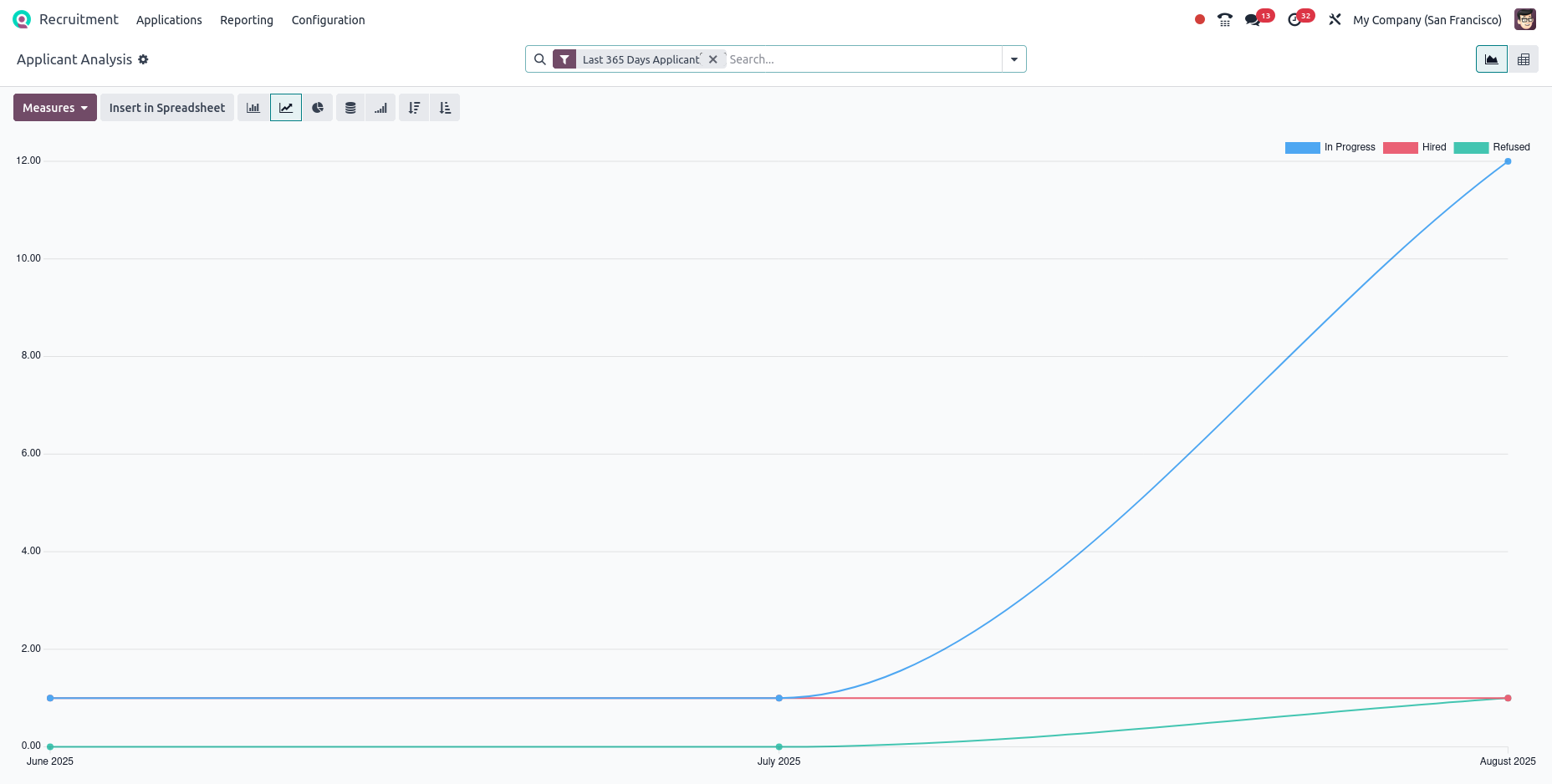
Pivot View
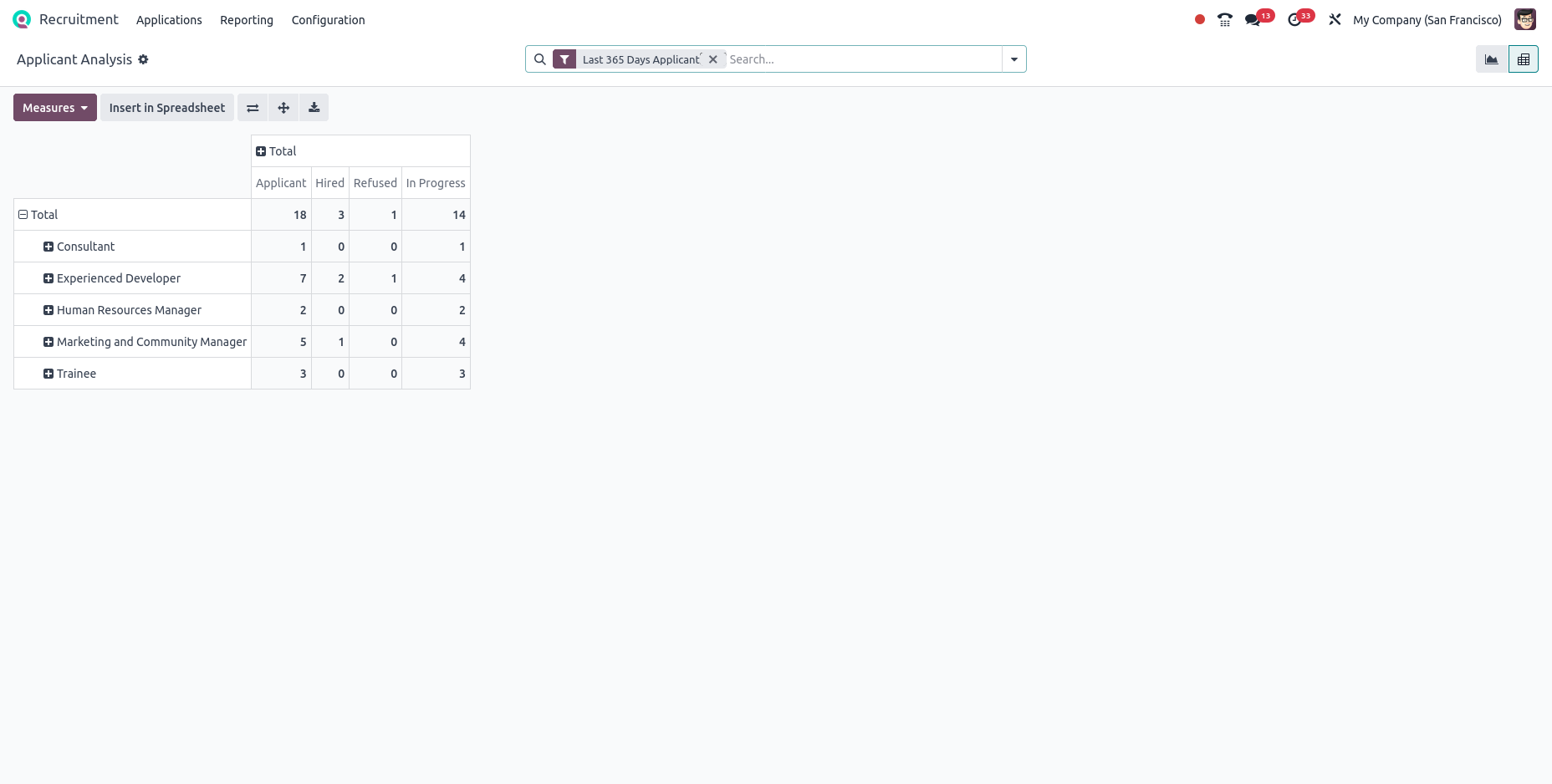
Source Analysis
Overview
The Source Analysis report in Odoo provides insights into the effectiveness of various applicant sources, helping recruitment teams understand which channels bring in the best candidates. This information helps teams adjust their strategies for attracting higher-quality applicants by analyzing where applicants are coming from, including the effectiveness of different platforms and mediums.
The following are the list of main features available in Source Analysis,
- Graph View: Displays the number of applicants by source and stage (In Progress, Hired) for the last 365 days
- Pivot Table View: Breaks down data by job position and stage, and allows filtering by source (e.g., Facebook, LinkedIn)
- Flip Axis: Swaps rows and columns to make source-to-job position data easier to read
- Medium Tracking: Allows grouping results by medium (e.g., social media, paid search) to see which methods are most effective
- Dynamic Data: Only mediums that have been set for applicants appear in the report for each source
Screenshots
Graph View
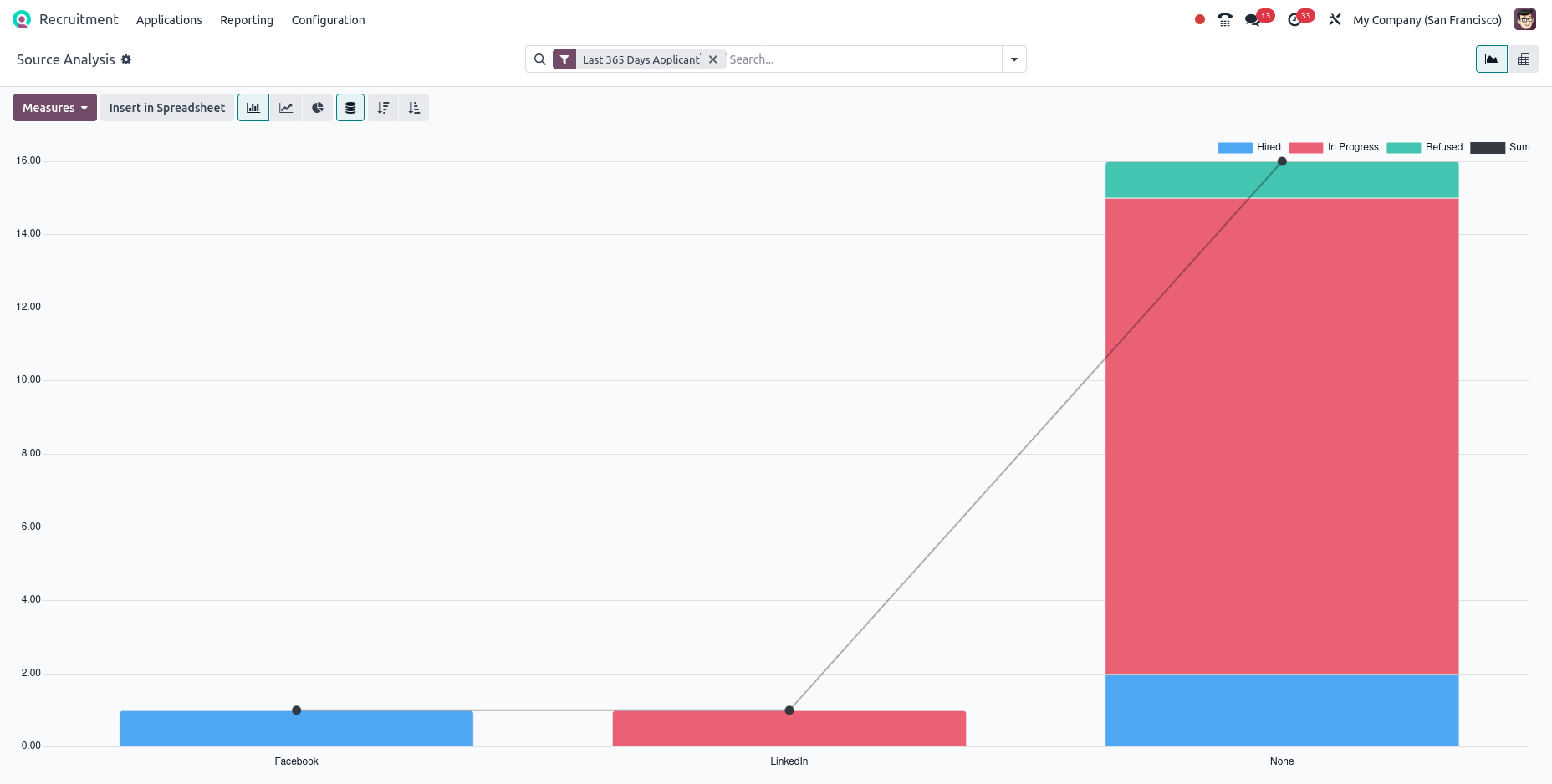
Pivot View
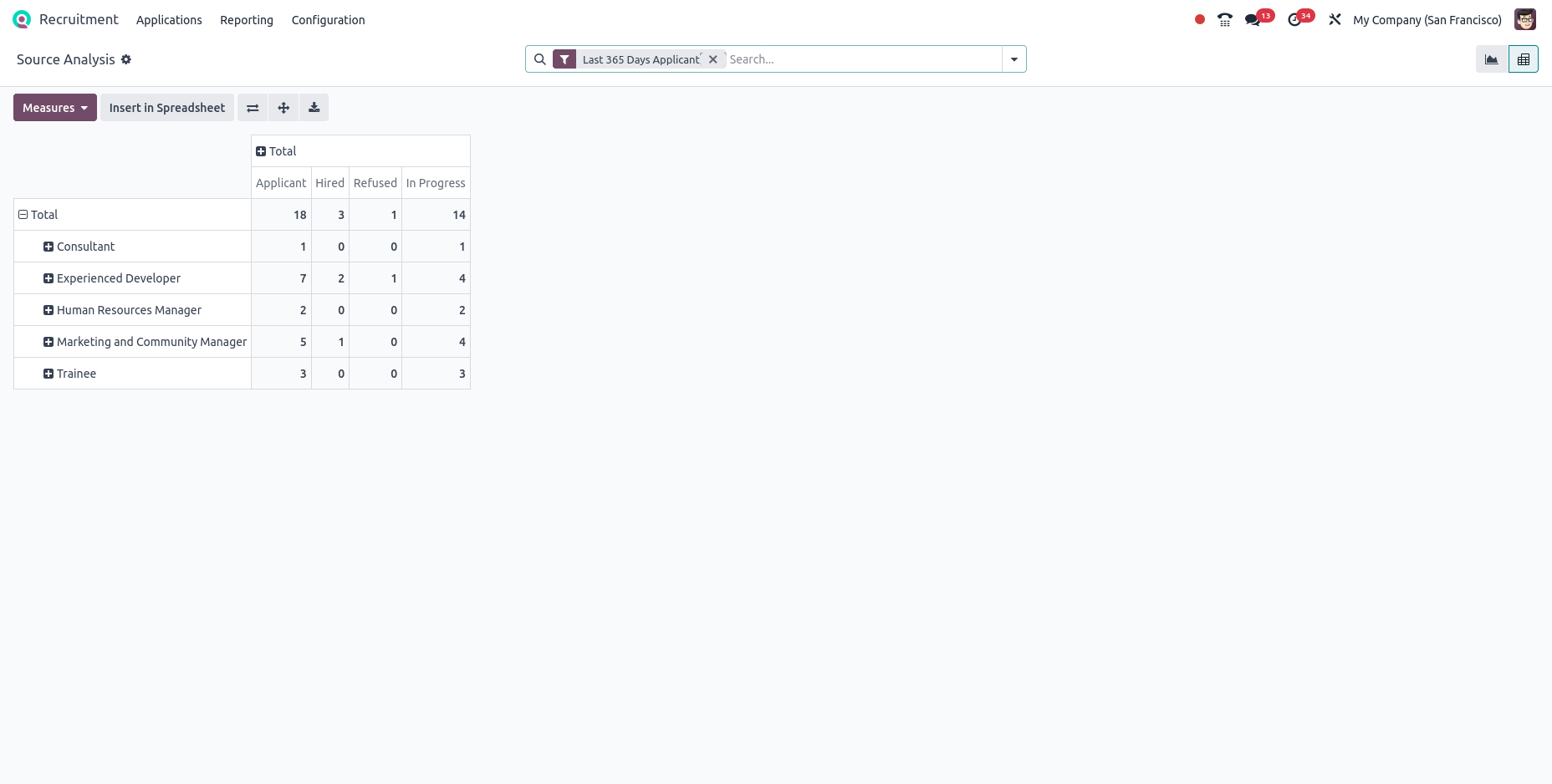
Velocity Analysis
Overview
The Velocity Analysis report tracks how long applicants spend in each recruitment stage, helping identify delays and bottlenecks. It provides insights in line, bar, or pivot table formats, allowing teams to optimize the recruitment process and move applicants more efficiently through each stage.
The following are the list of main features available in Velocity Analysis,
- Line Chart View: Displays how long applicants stay in each stage, with stages on the x-axis and days on the y-axis, for the last 365 days
- Bar Chart View: Offers a more visually digestible view, helping recruiters easily spot bottlenecks by comparing stages across job positions
- Pivot Table View: Provides detailed breakdowns by job position and stage, showing average days in each stage
- Month Comparison: Allows grouping by month to see if certain months have longer wait times for applicants in specific stages
- Custom Grouping: Enables grouping data by start date and viewing time in stage by month
- Delayed Stages: Helps identify which stages have the longest wait times, highlighting potential delays or bottlenecks
Screenshots
Graph View
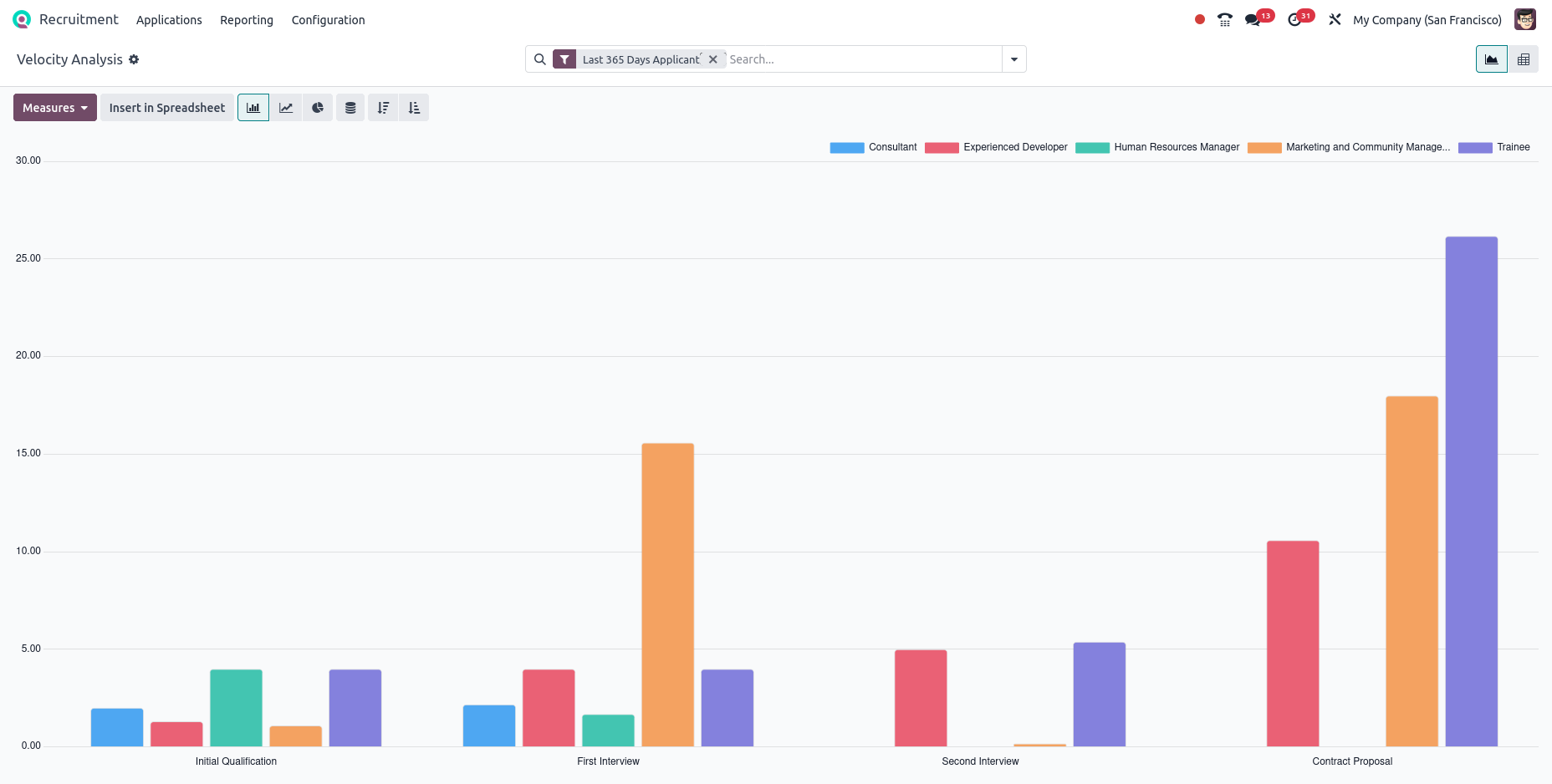
Pivot View
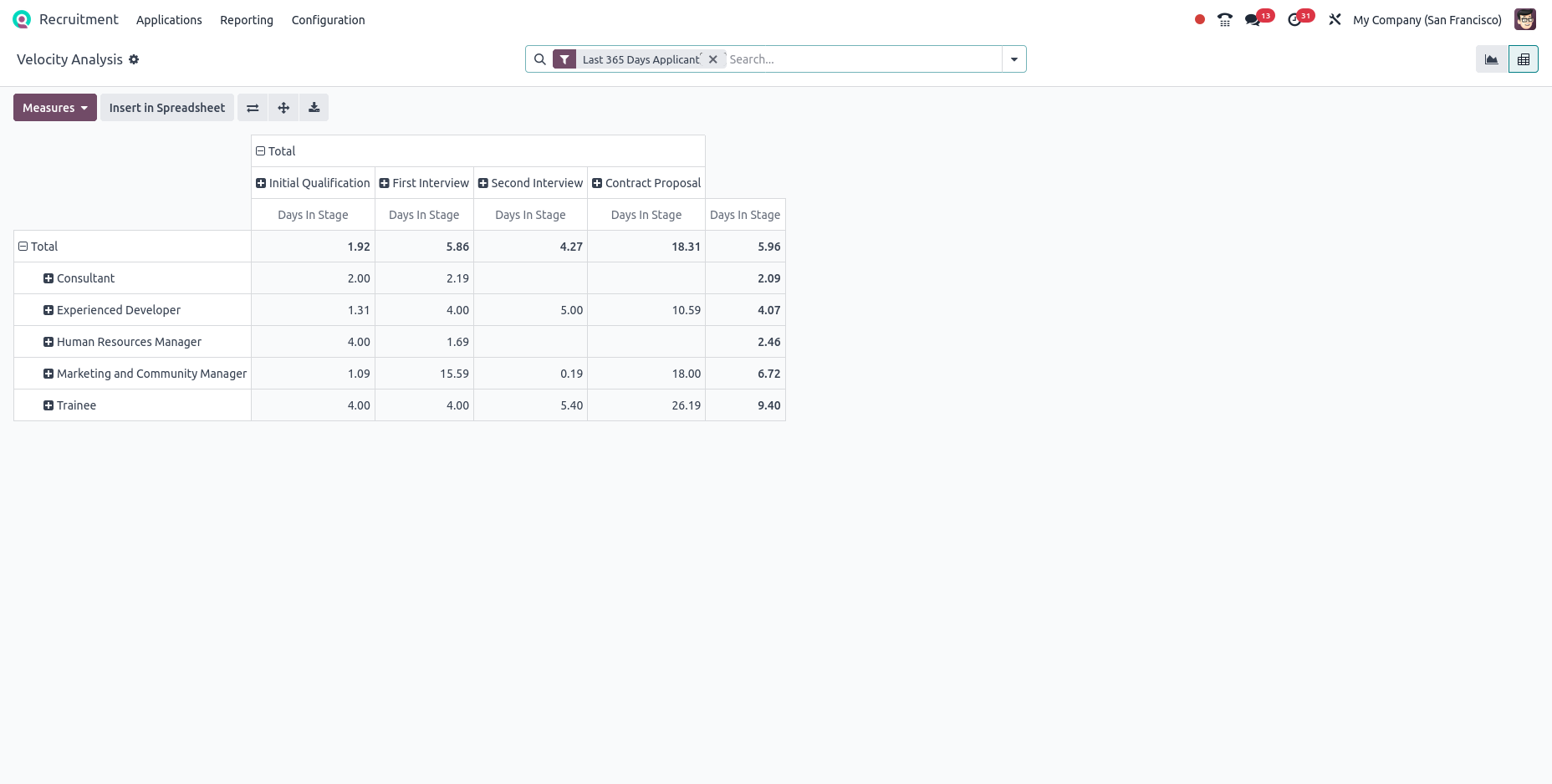
Team Performance
Overview
The Team Performance report tracks recruiters’ performance by showing the number of applicants they manage, categorized by status (In Progress, Hired, Refused). It provides insights through graph and pivot table views, allowing comparisons over time (e.g., quarterly) to evaluate trends and optimize recruitment strategies.
The following are the list of main features available in Velocity Analysis,
- Graph View: Displays the number of applicants (In Progress, Hired, Refused) managed by each recruiter for the last 365 days
- Pivot Table View: Offers a detailed breakdown by job position, showing total applicants, hires, refusals, and those still in progress
- Recruiter Performance Over Time: Allows comparison of recruiter performance across different time periods (e.g., Q2 vs Q3)
- Custom Grouping: Enables grouping by recruiter to view individual performance metrics
- Time Period Comparison: Lets recruiters compare performance across specific periods (e.g., quarterly) to identify trends and improvements
Screenshots
Graph View
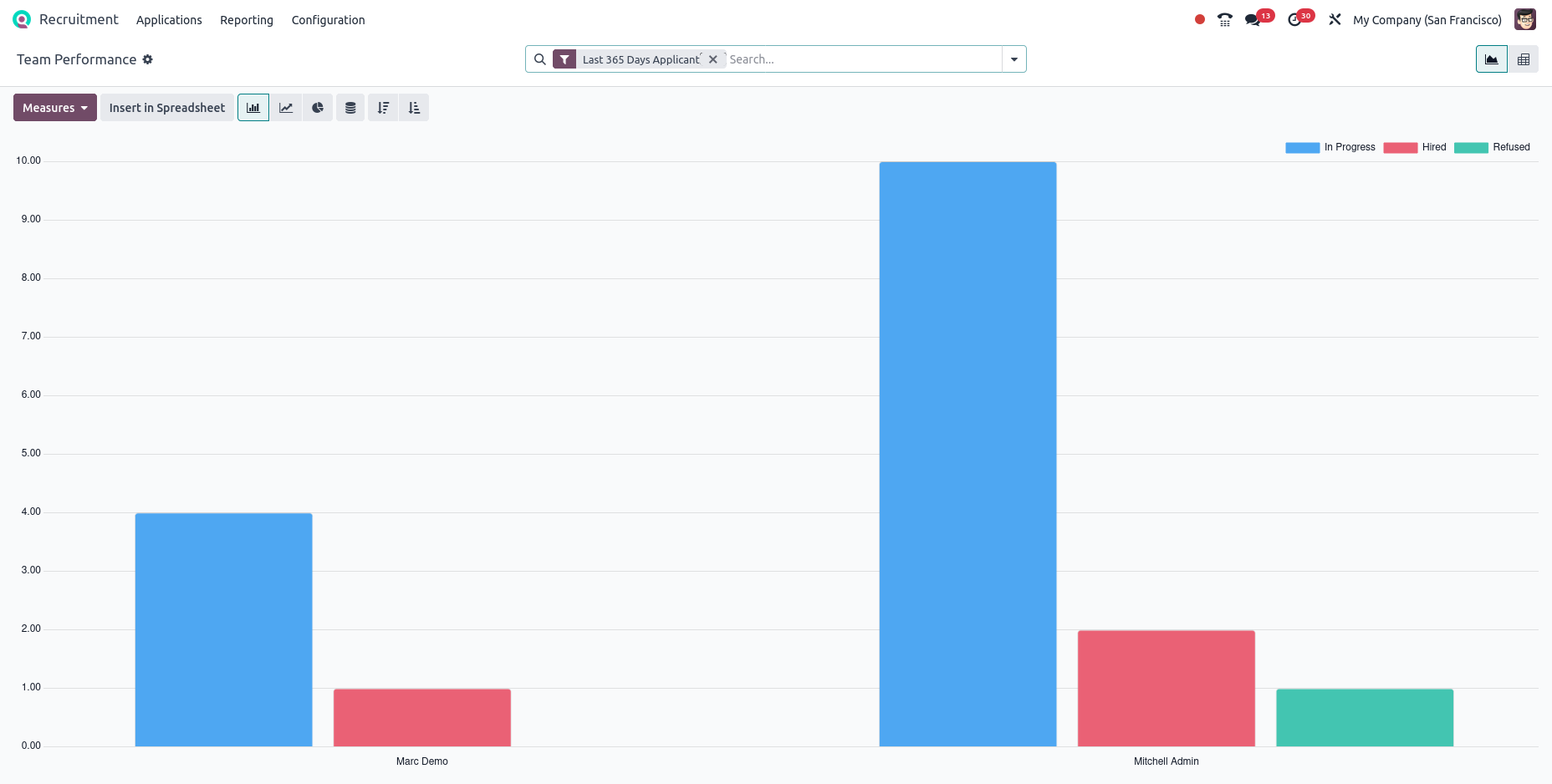
Pivot View
